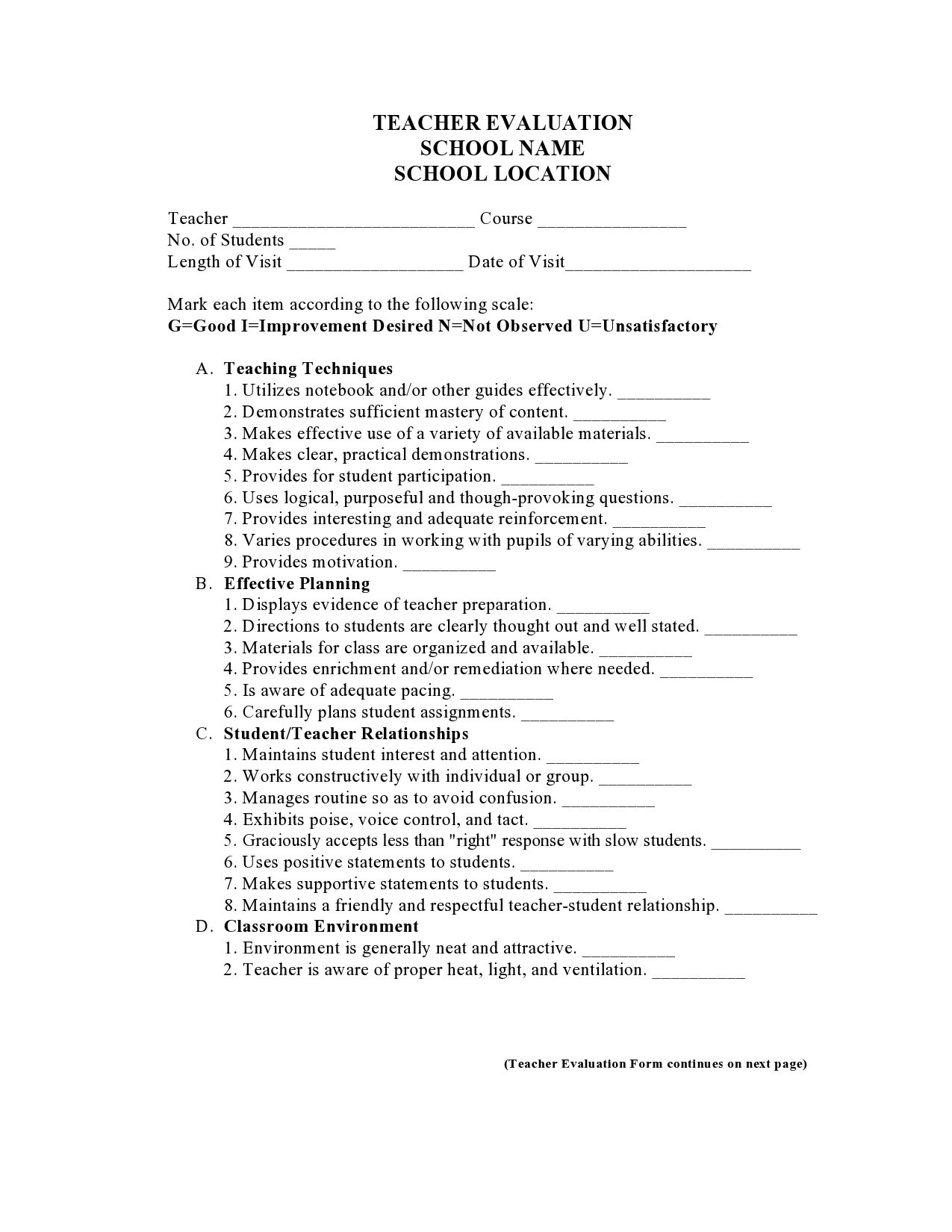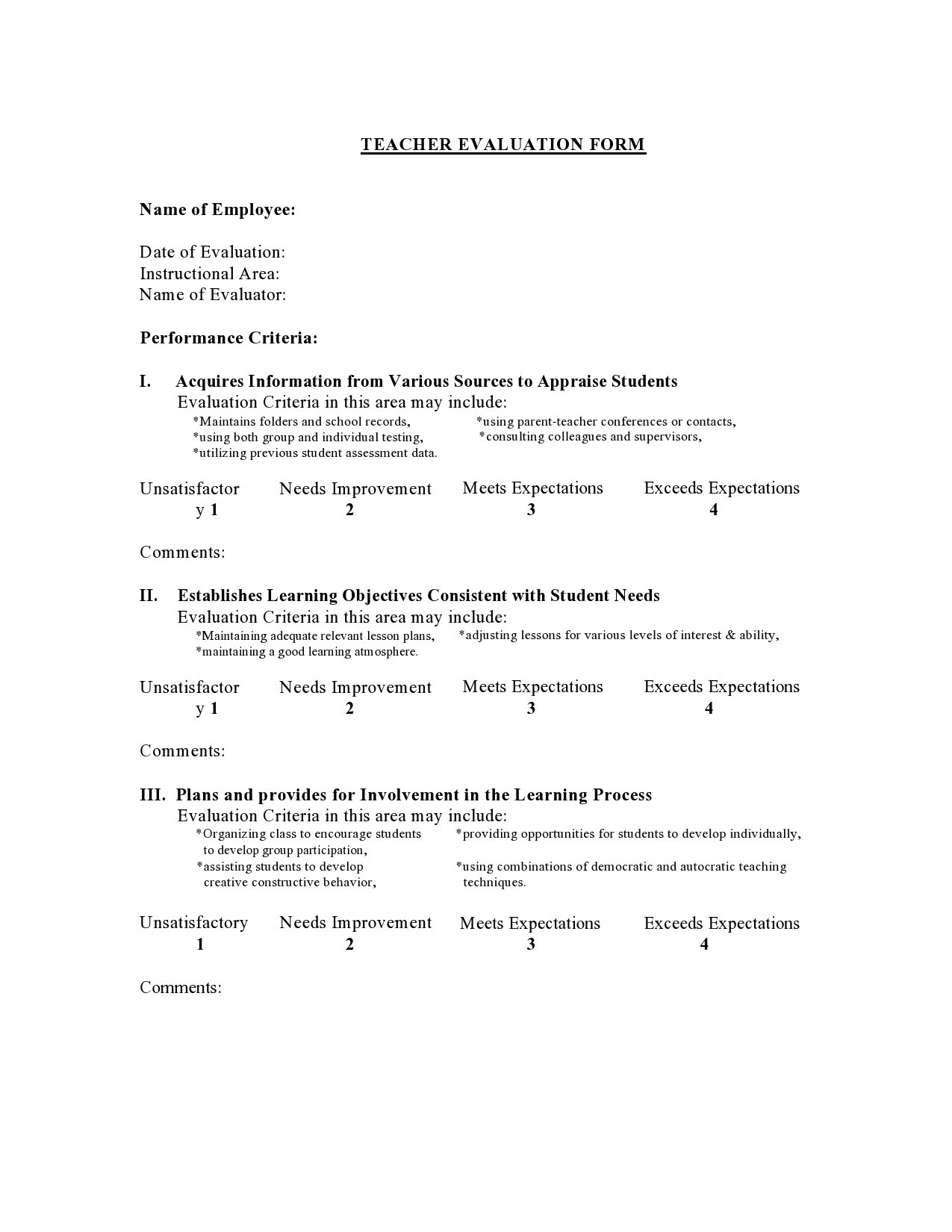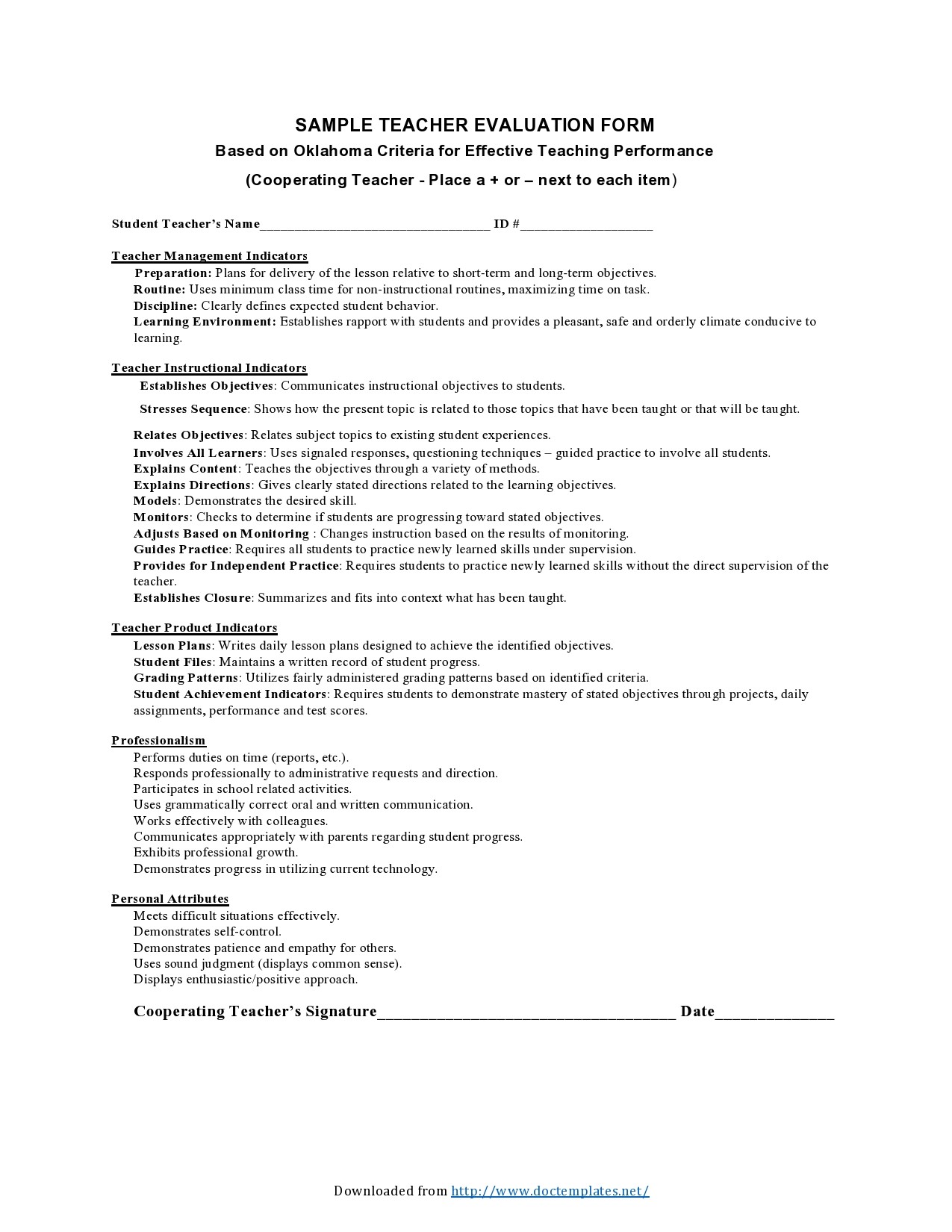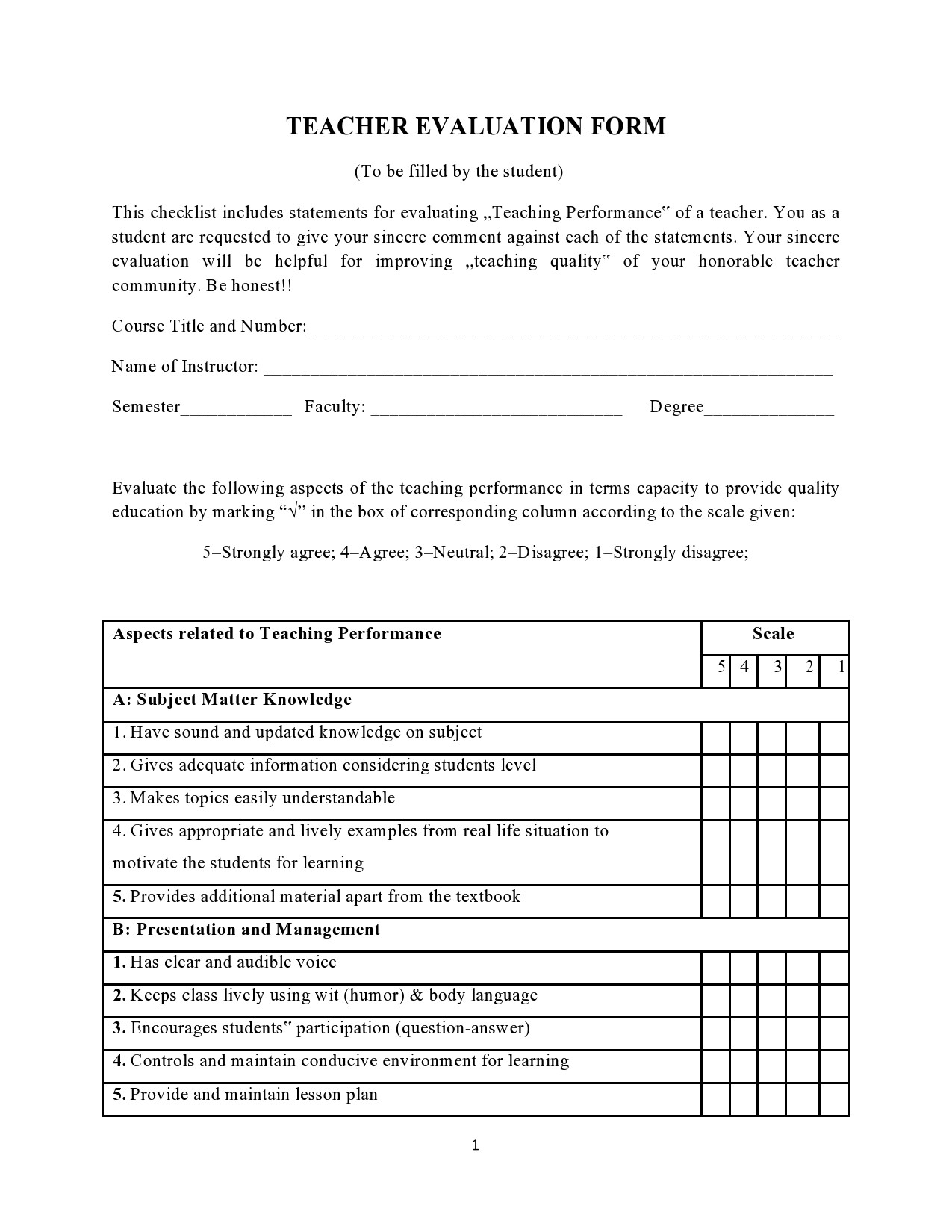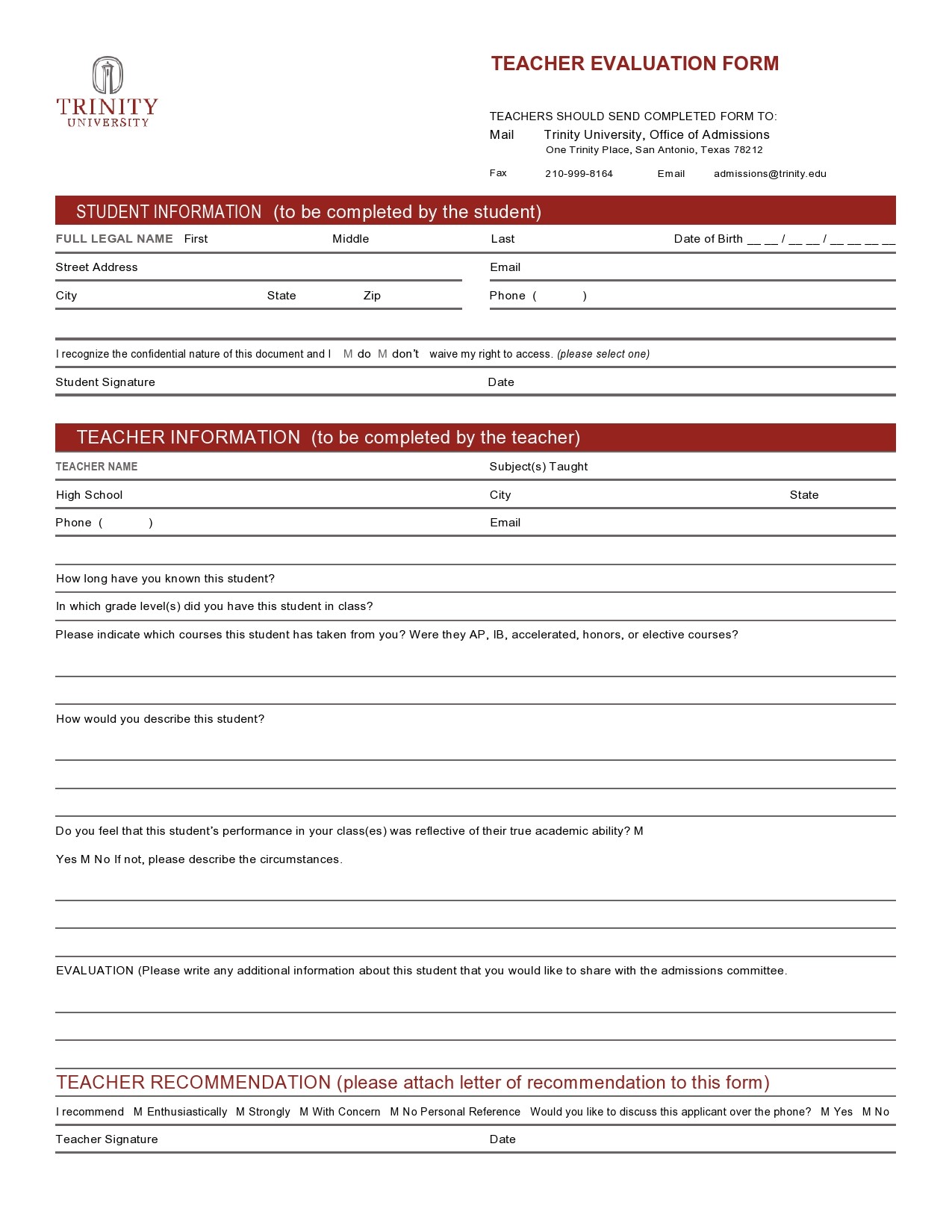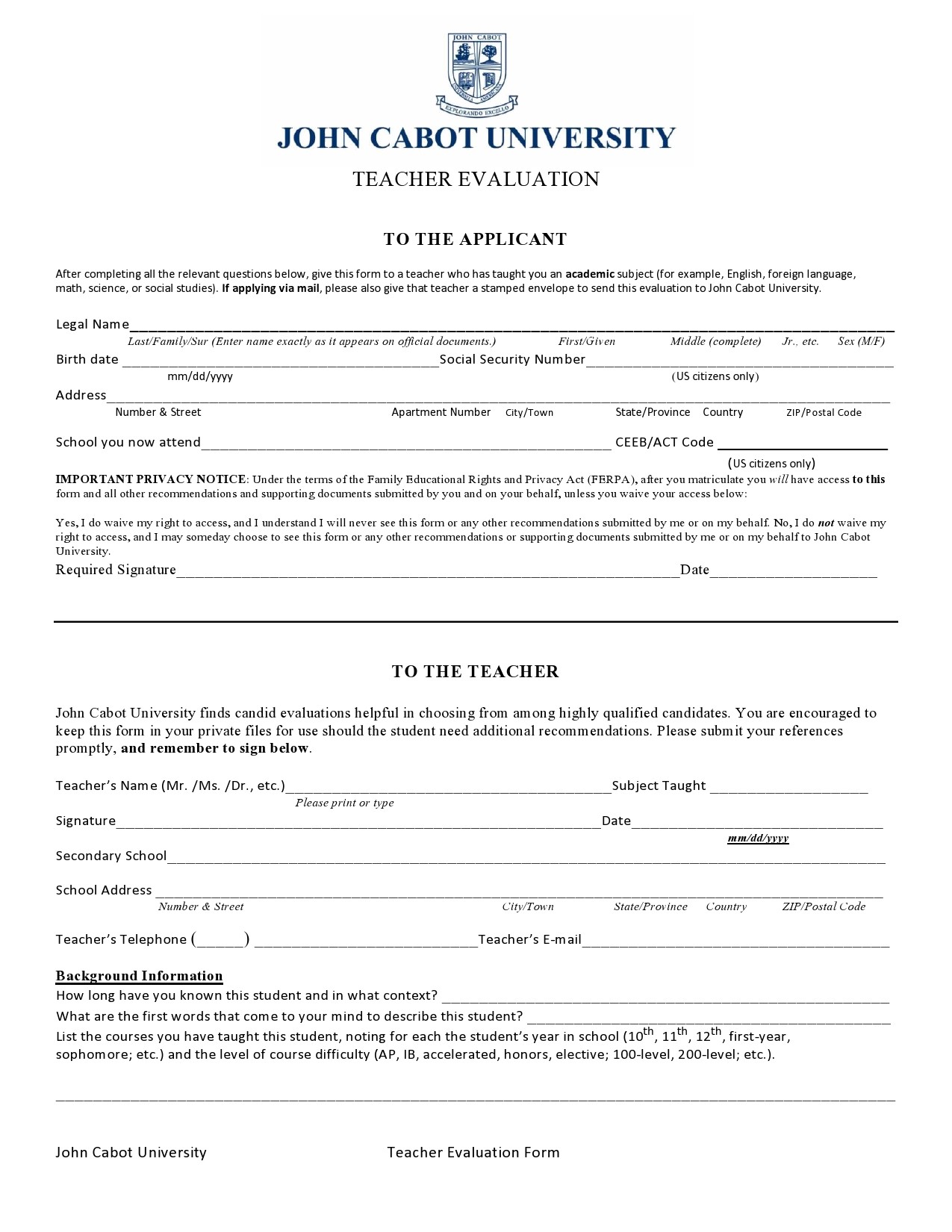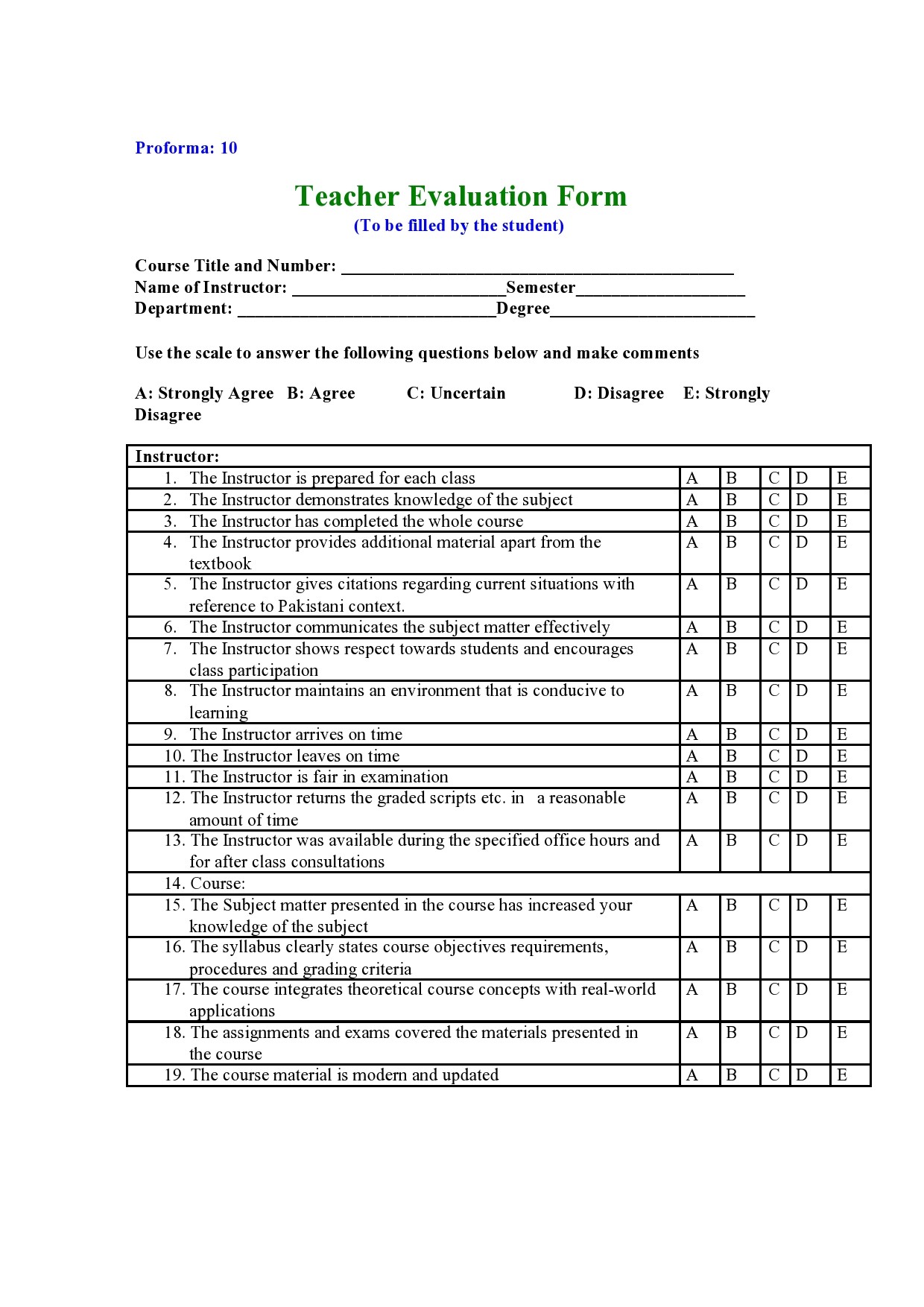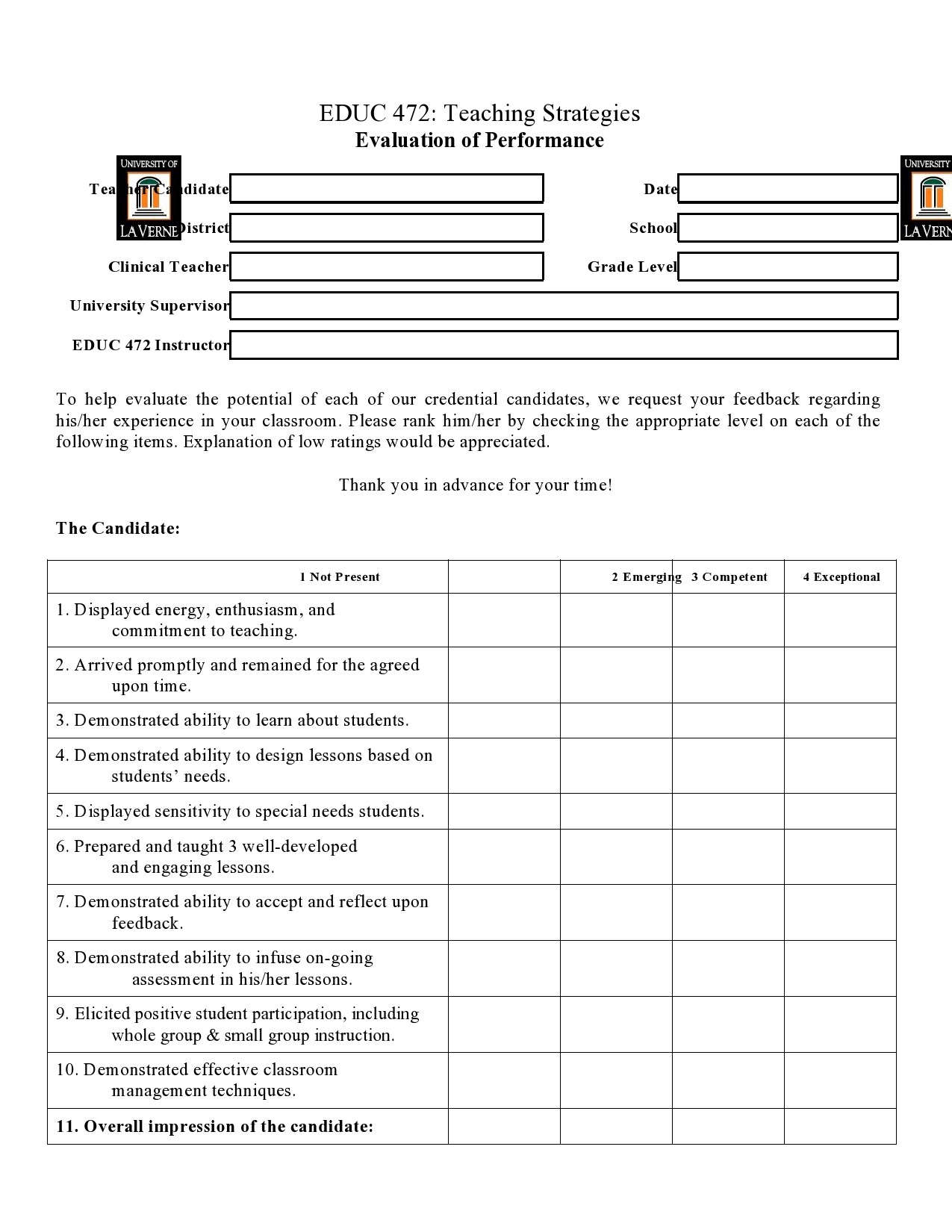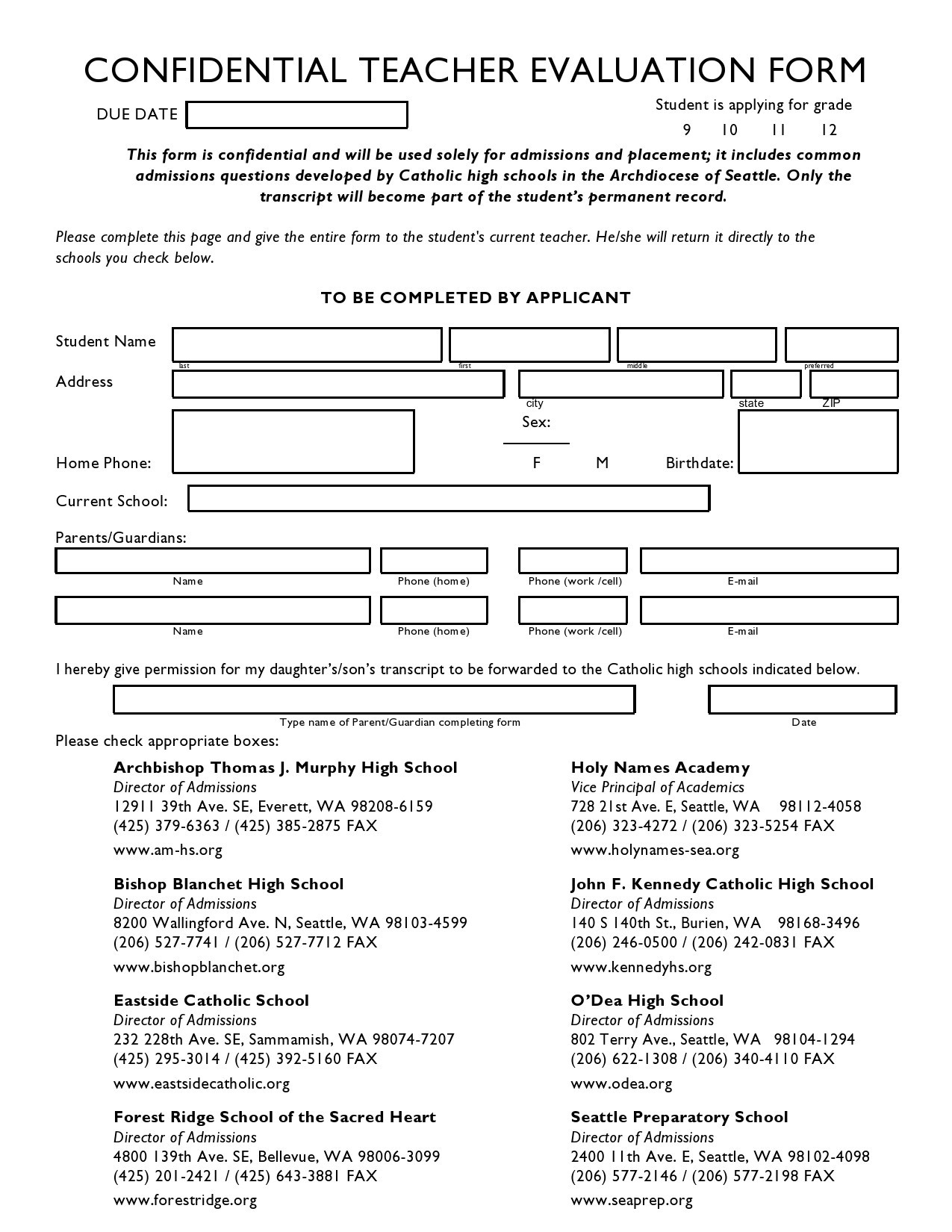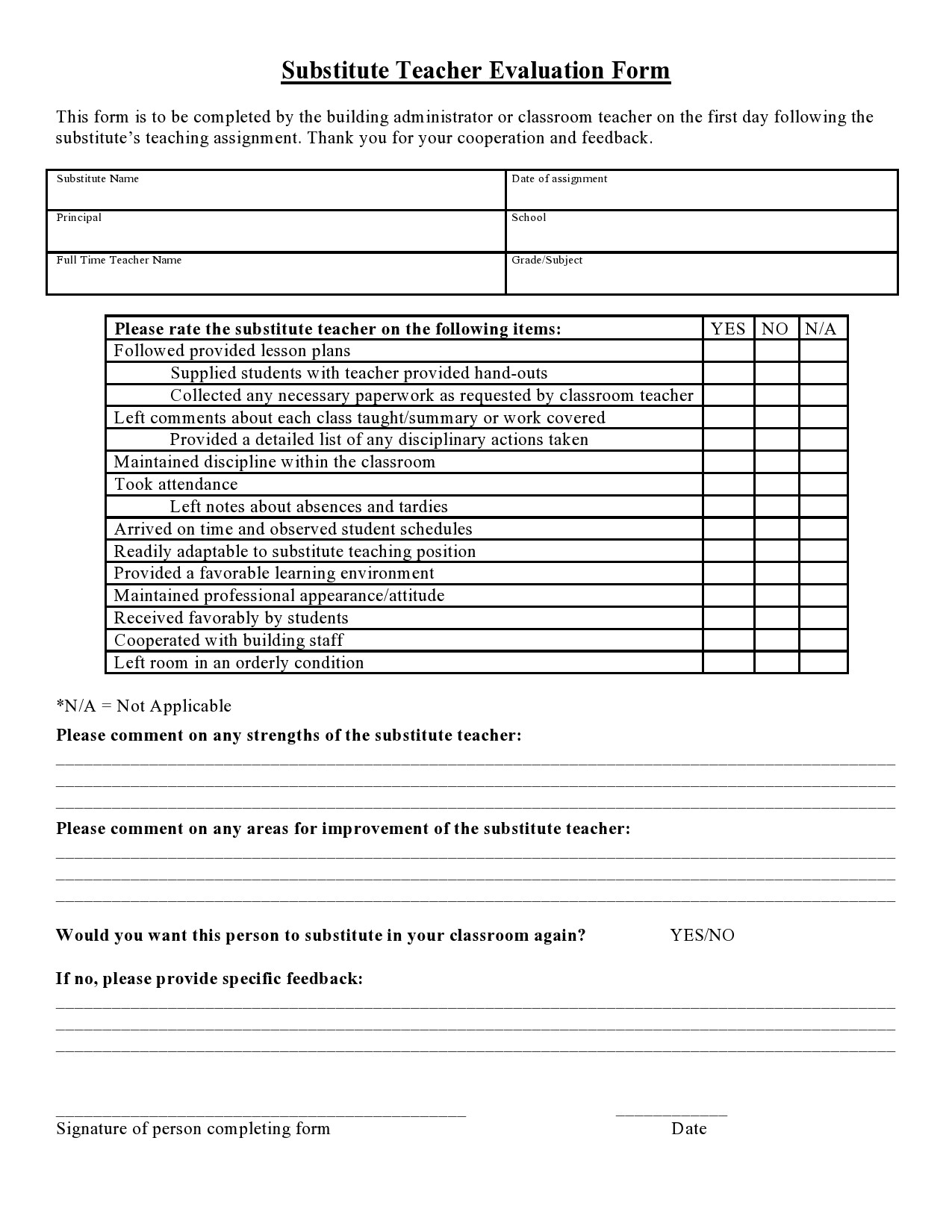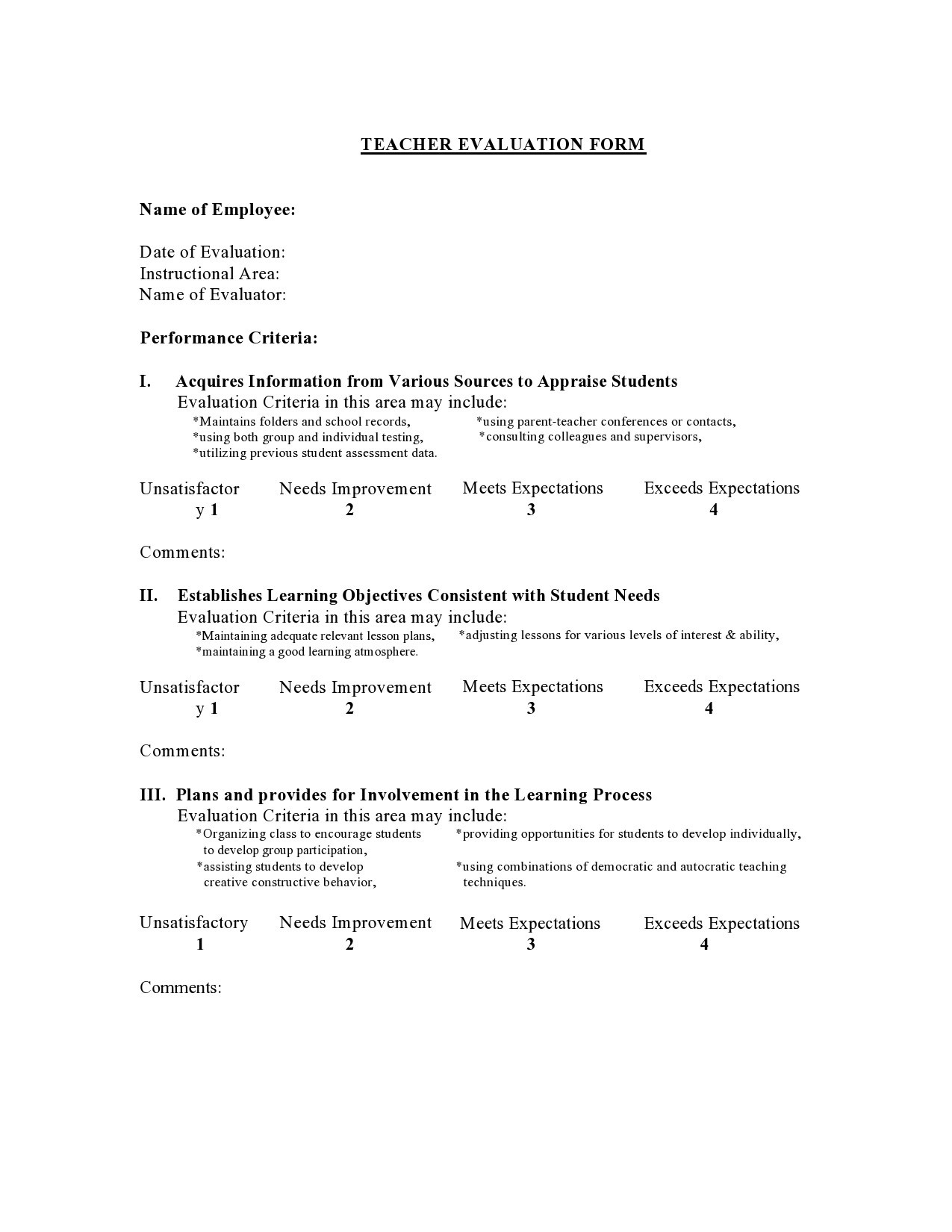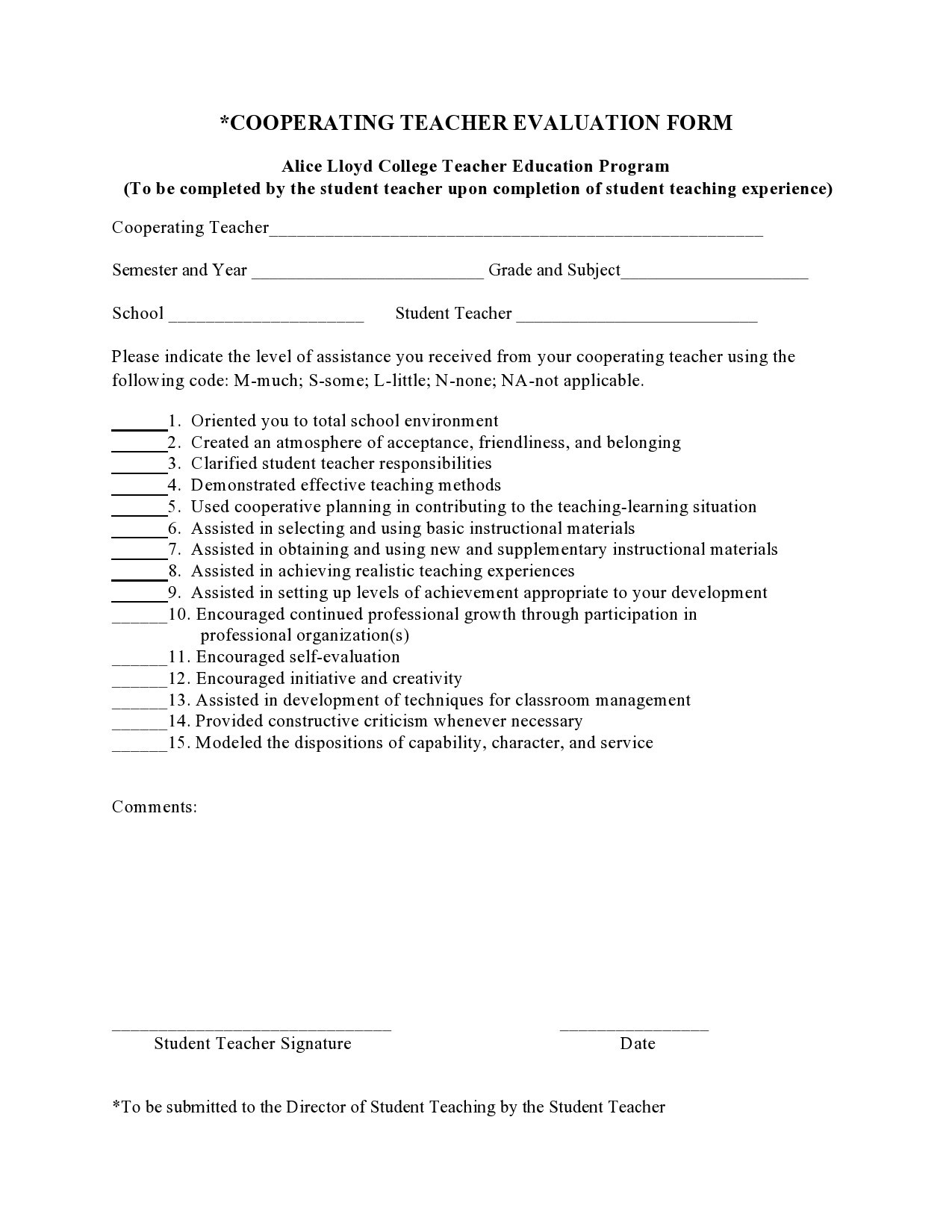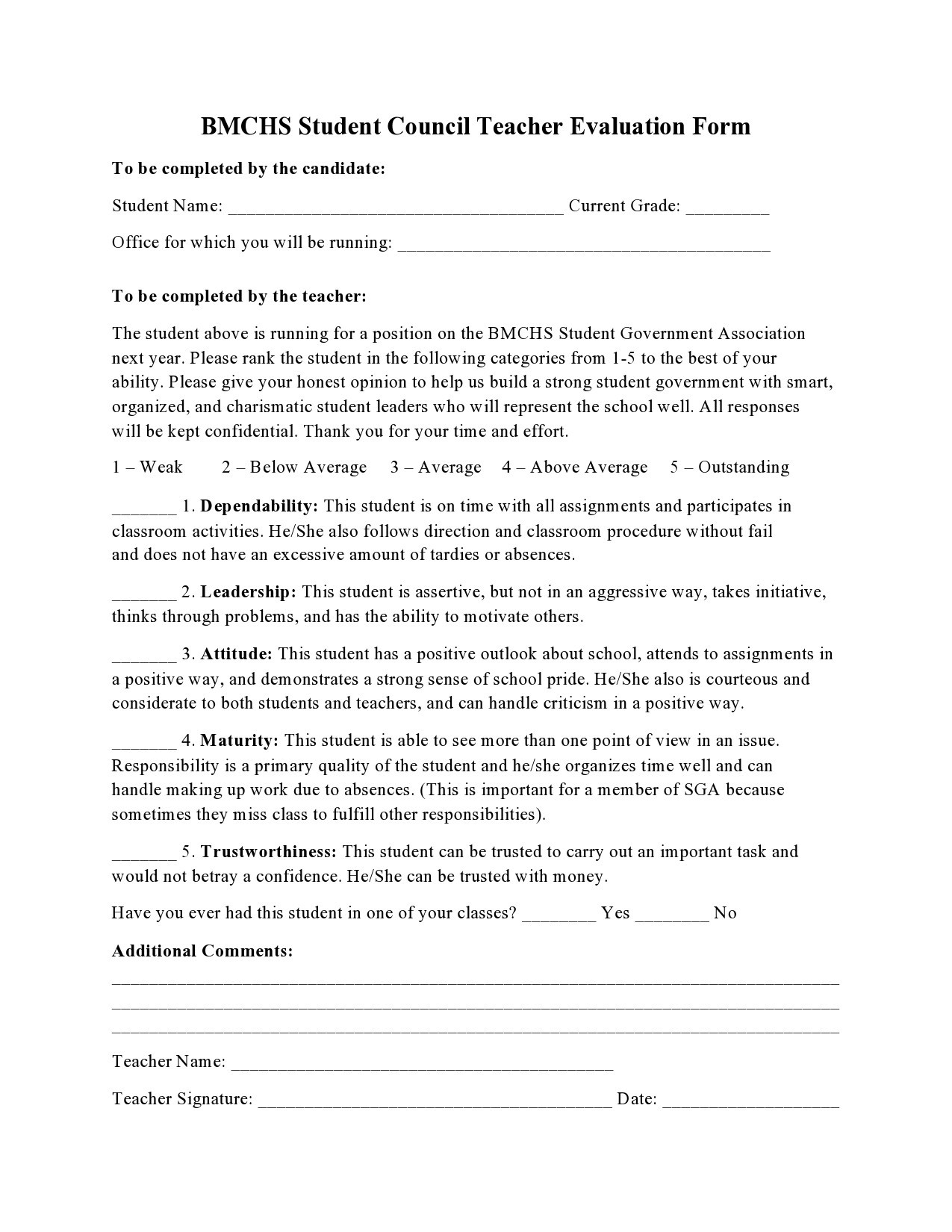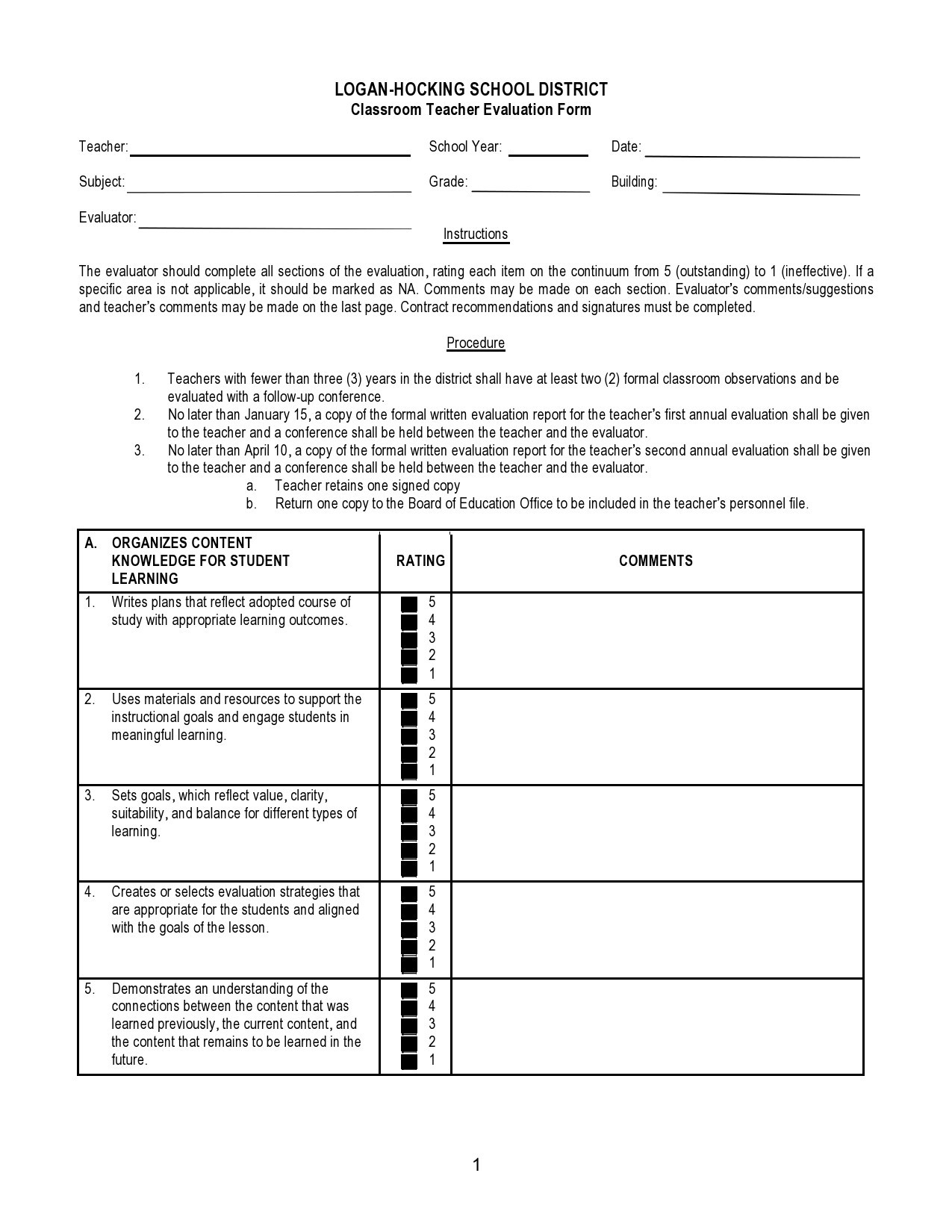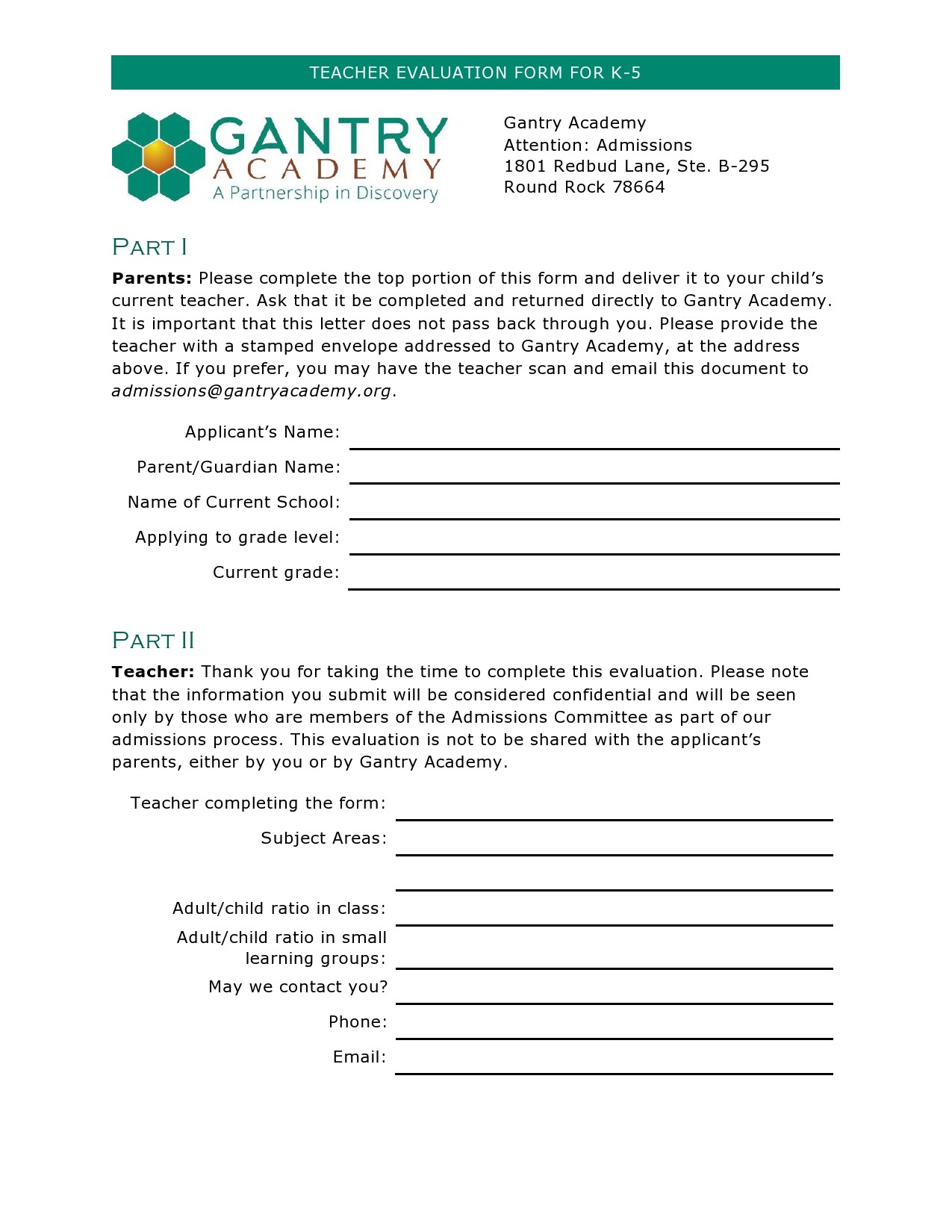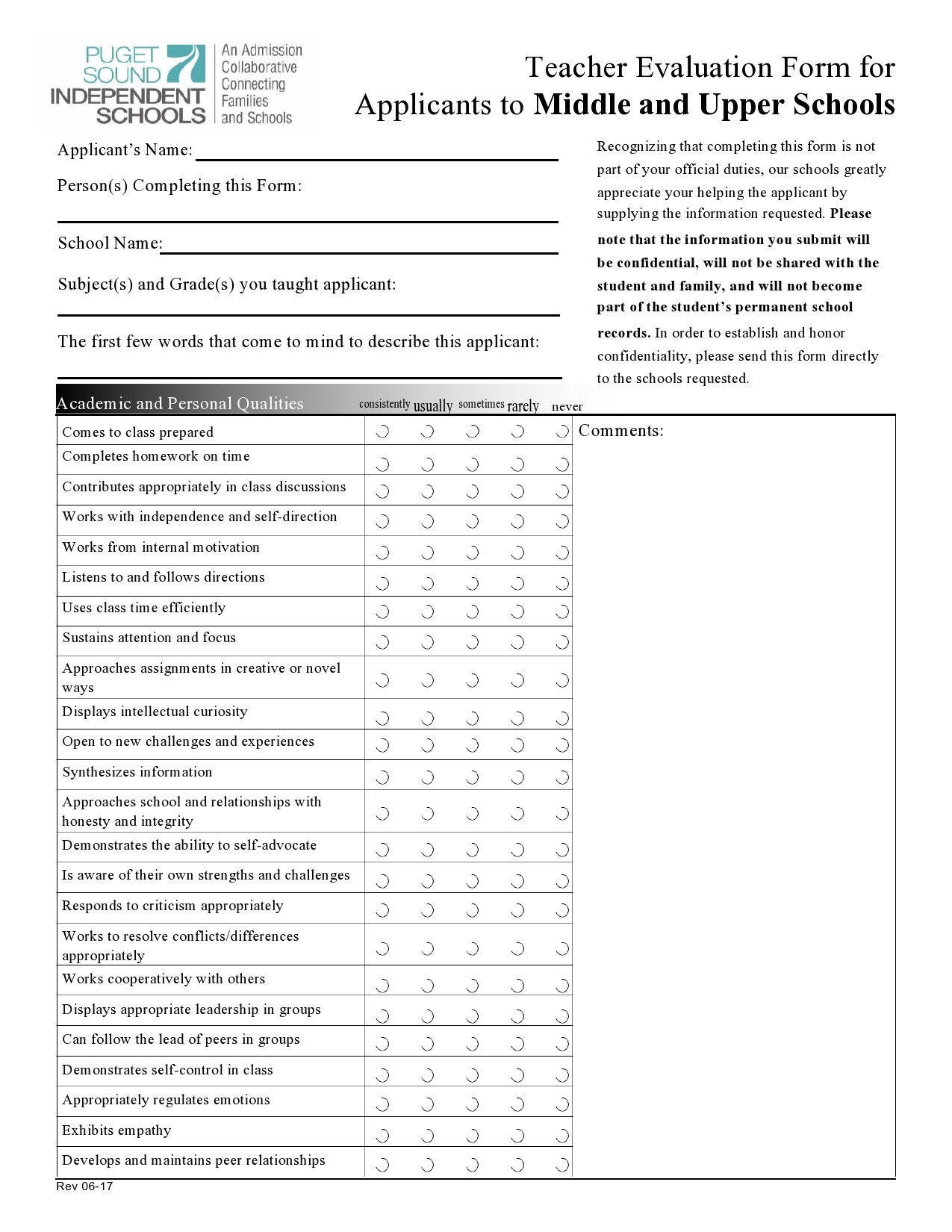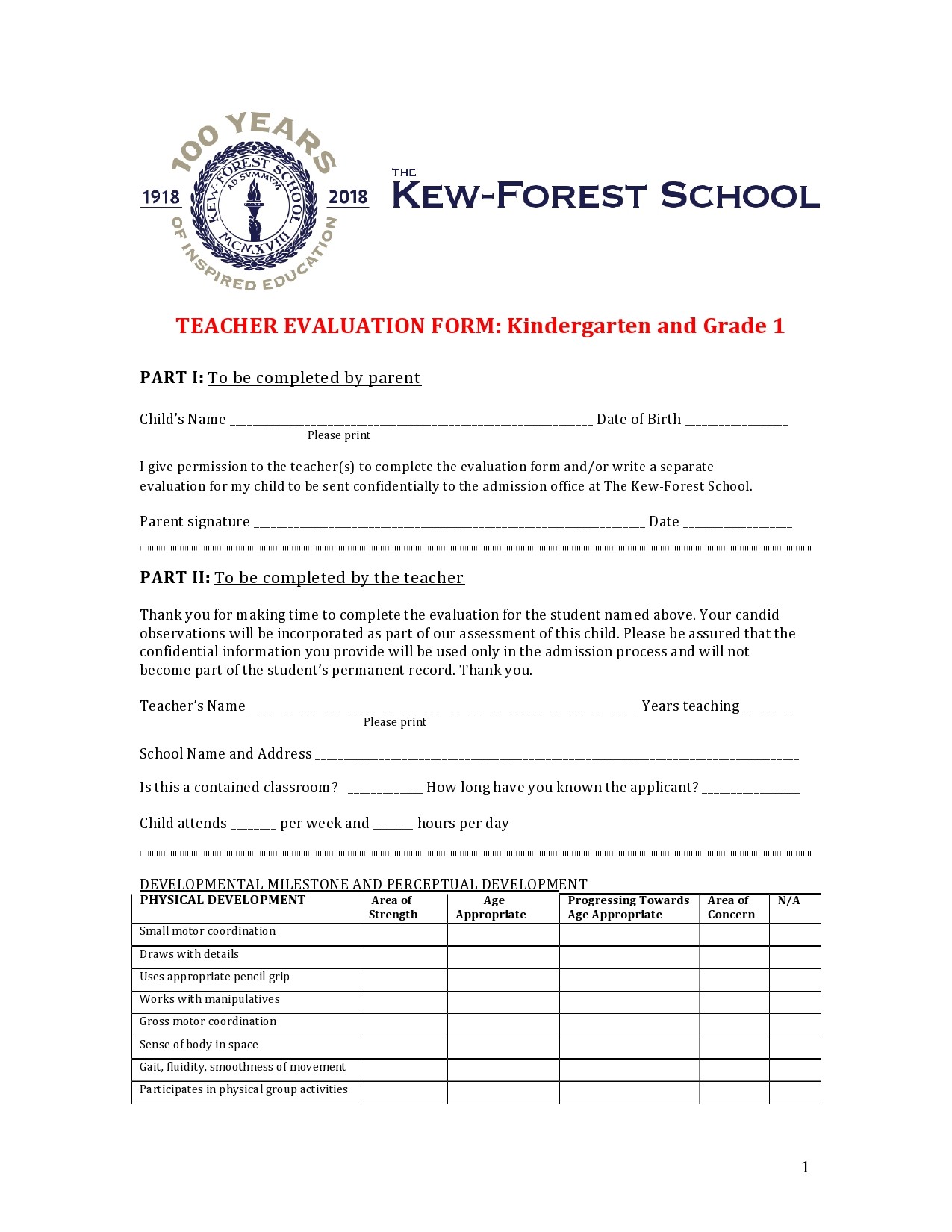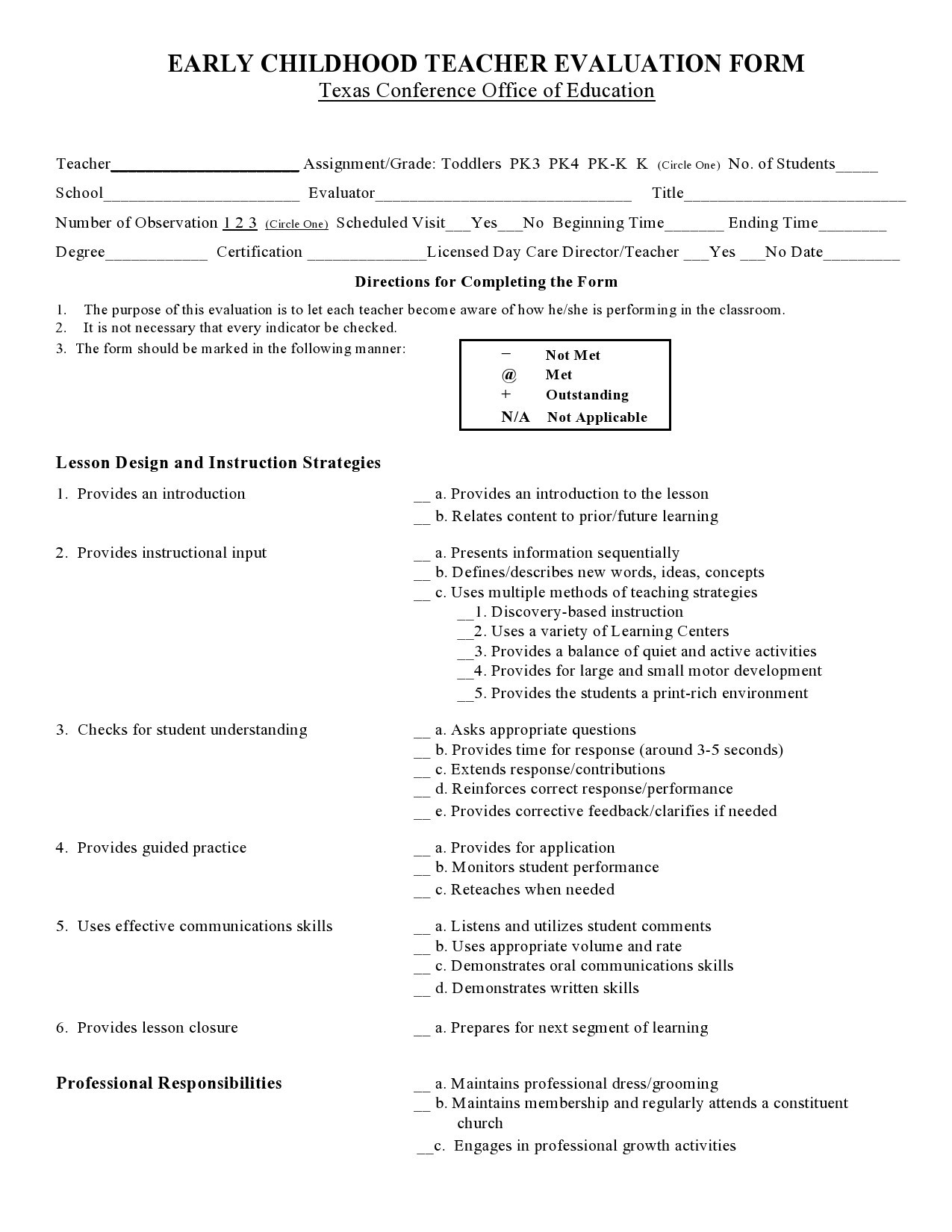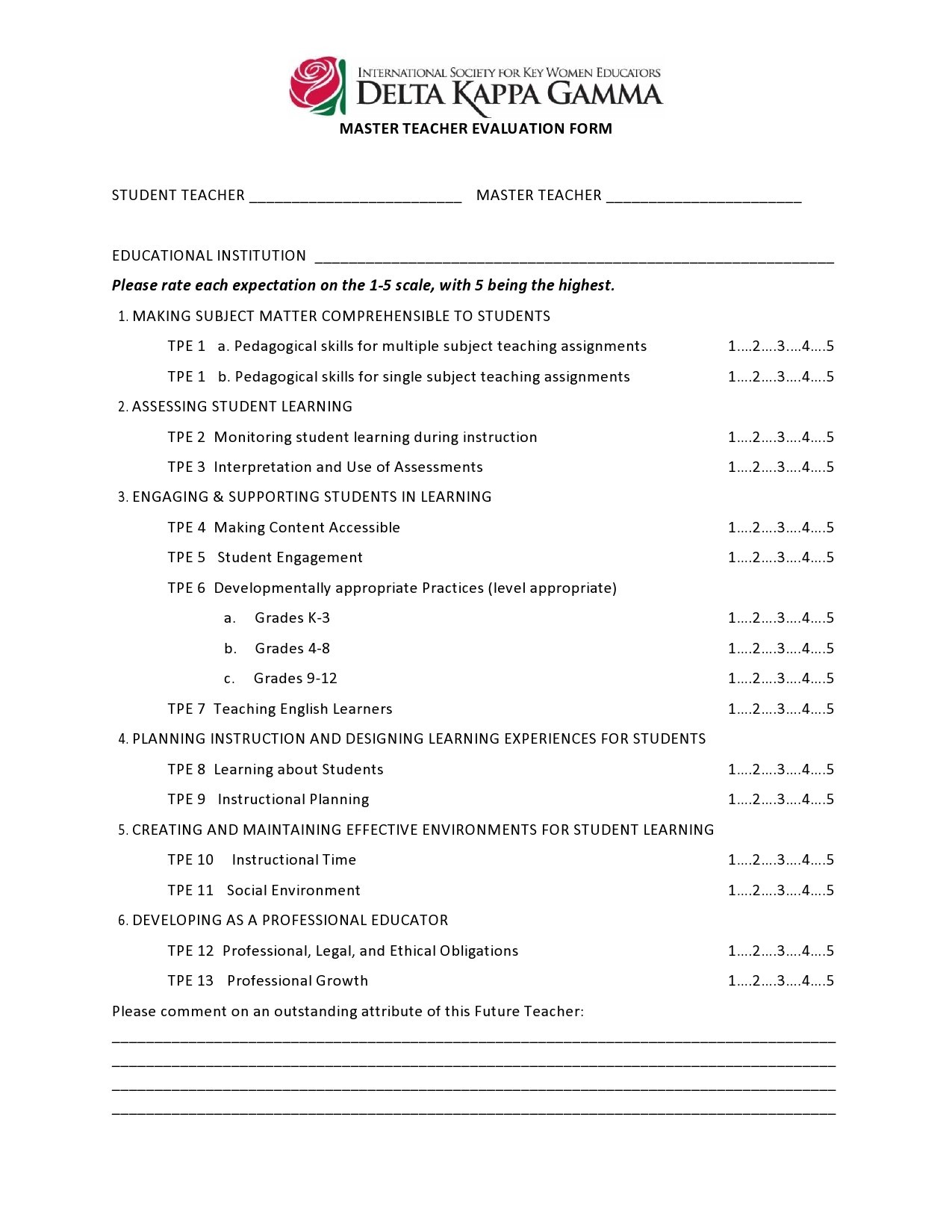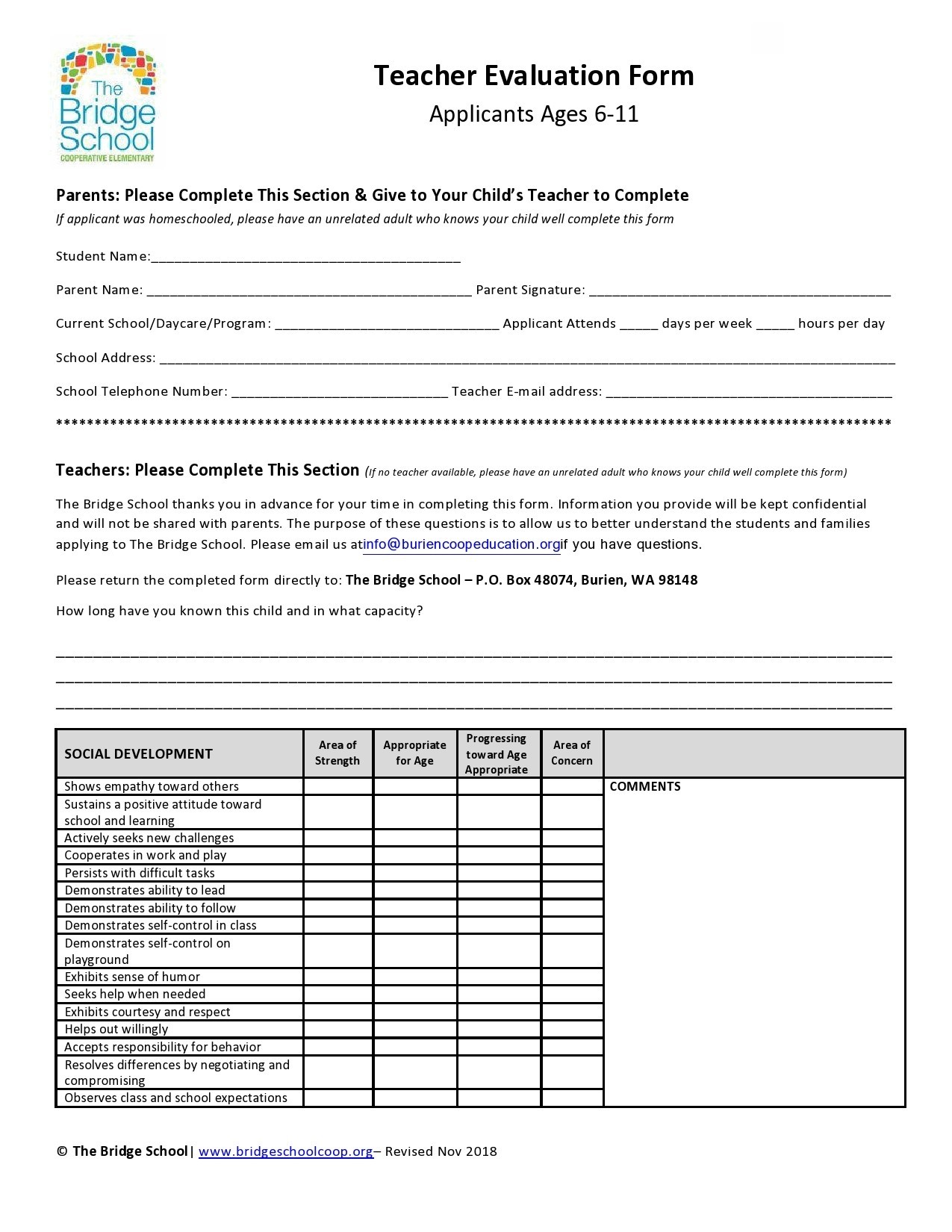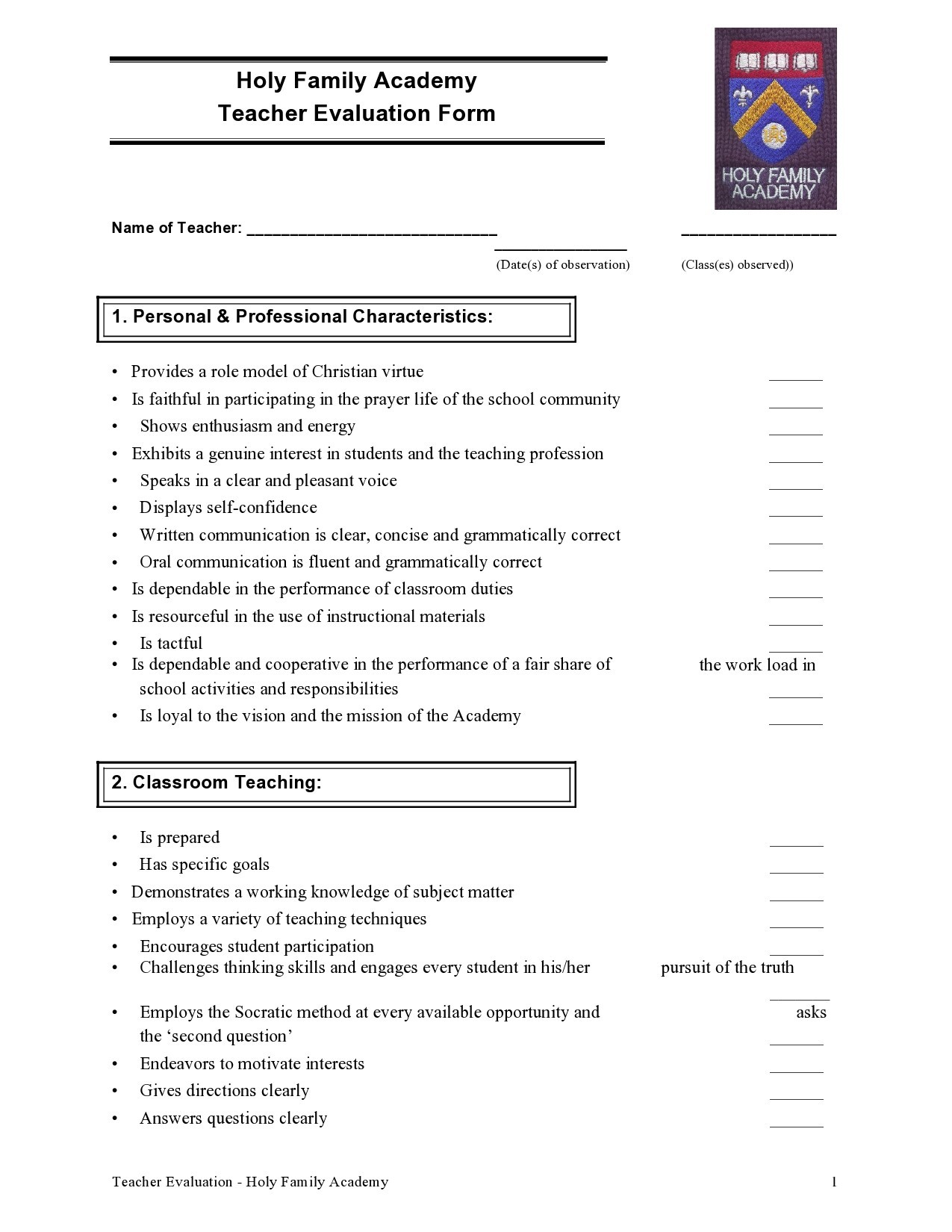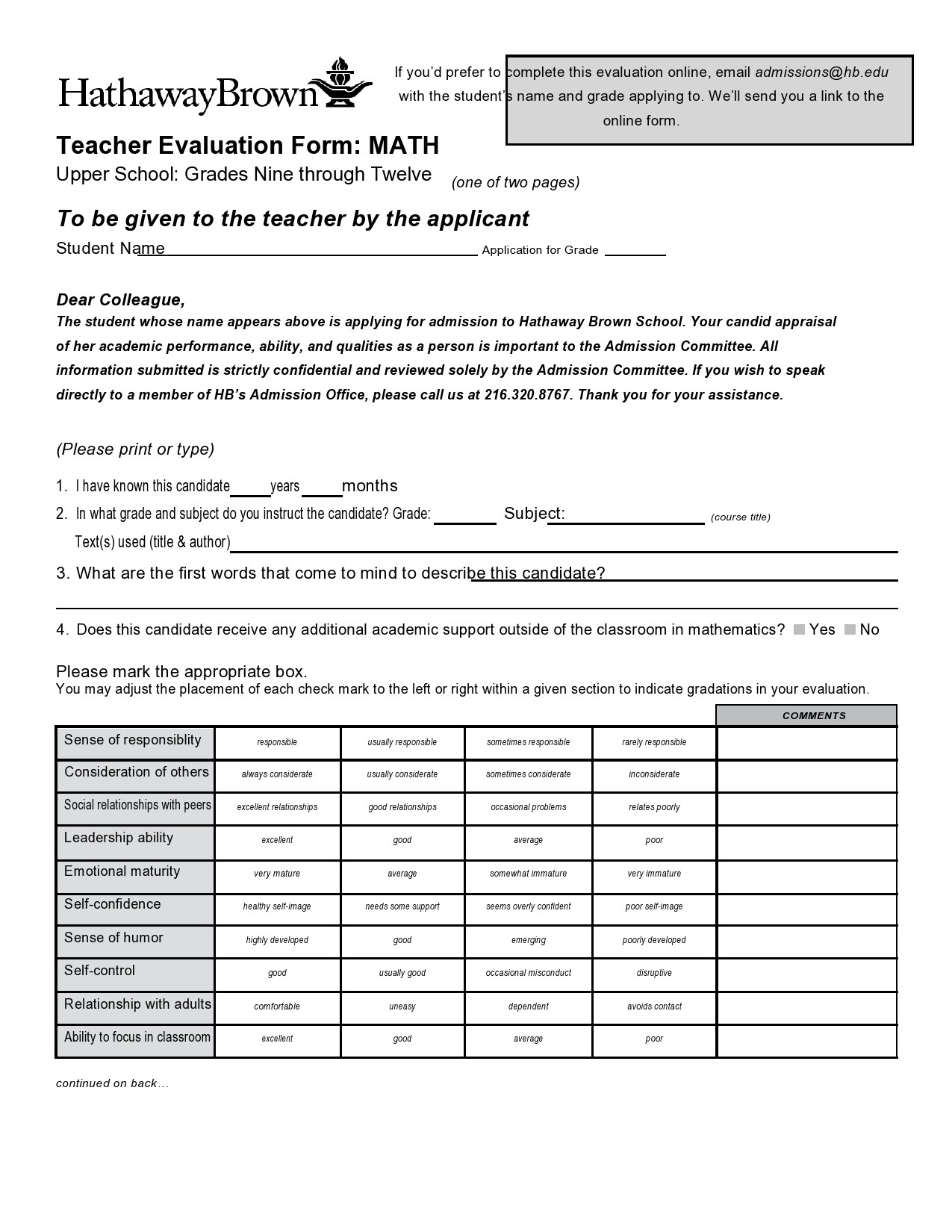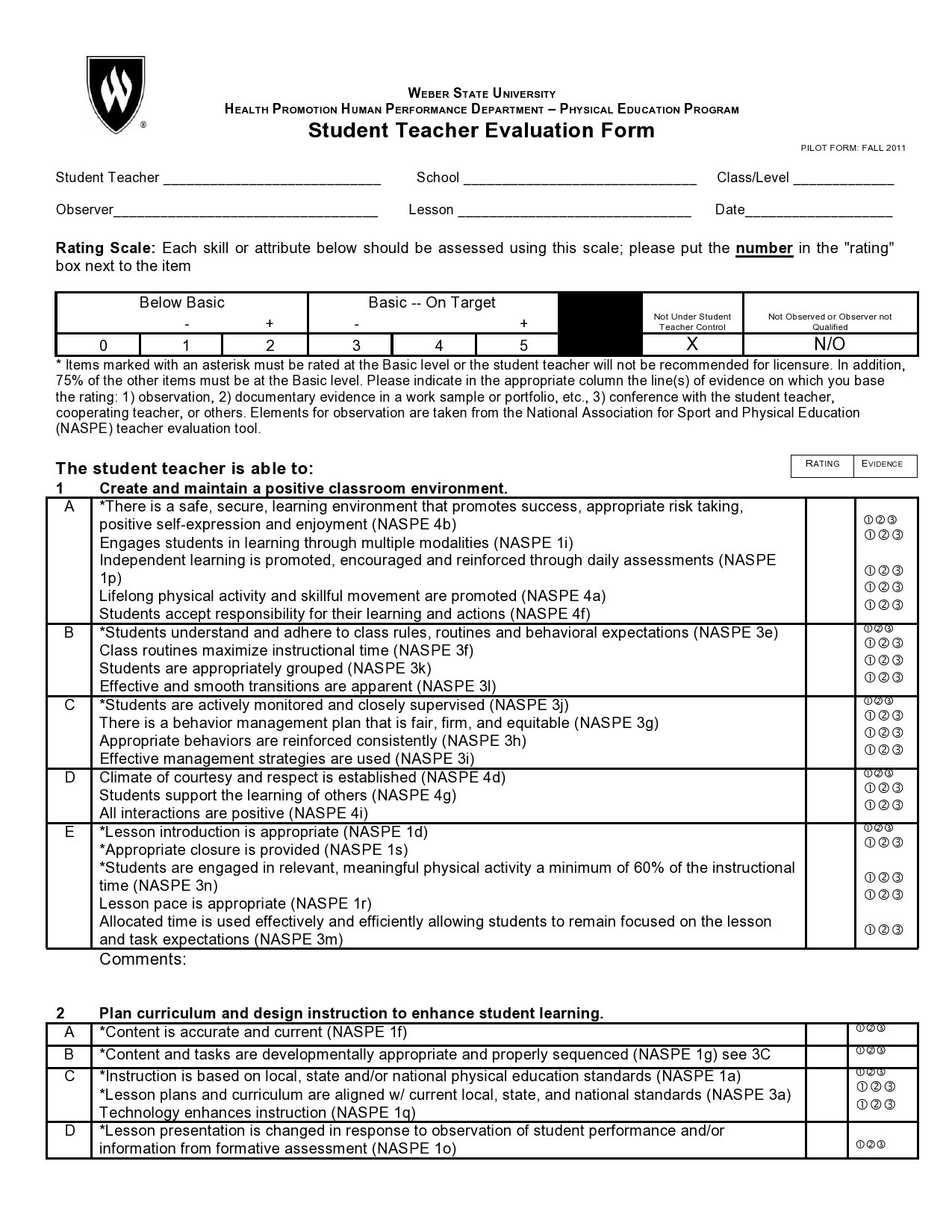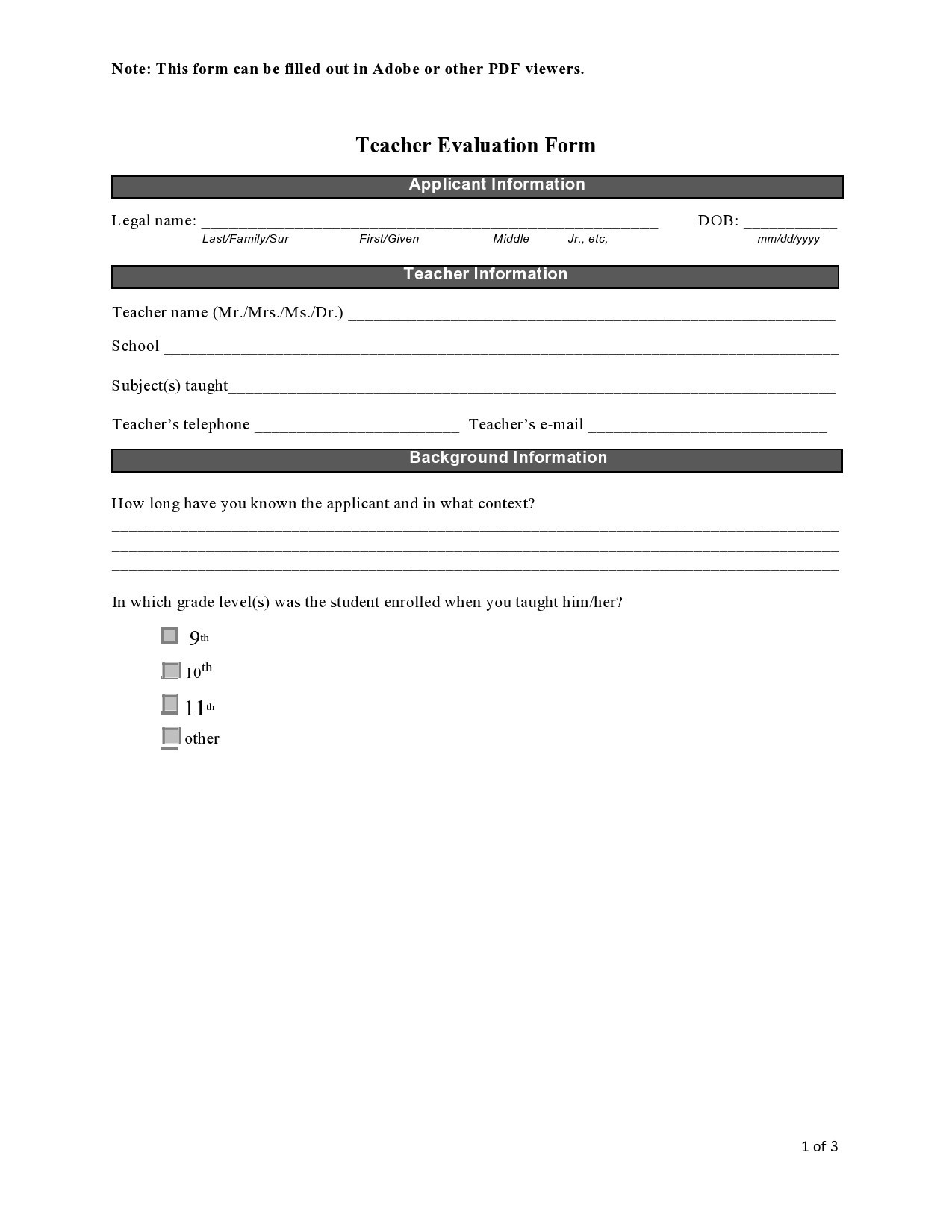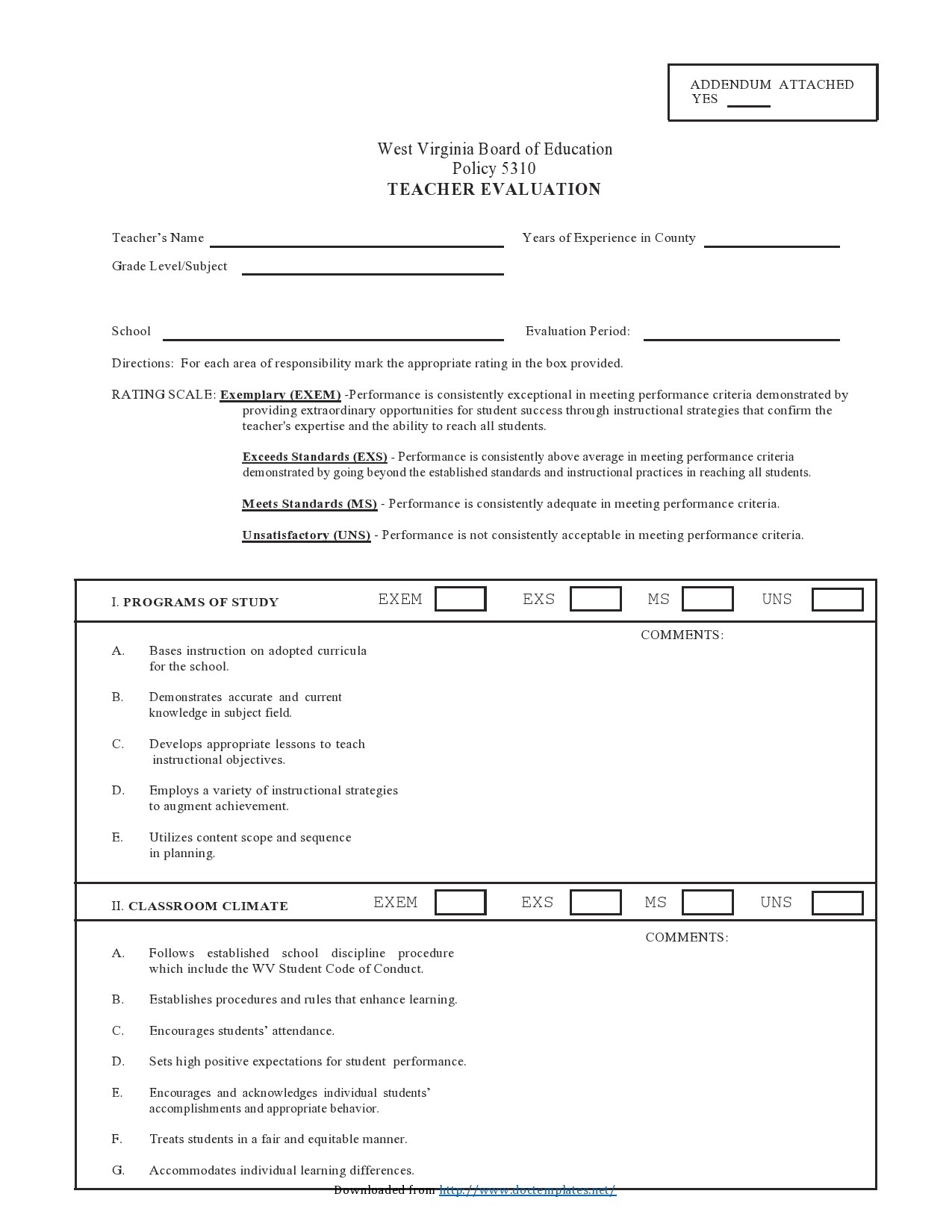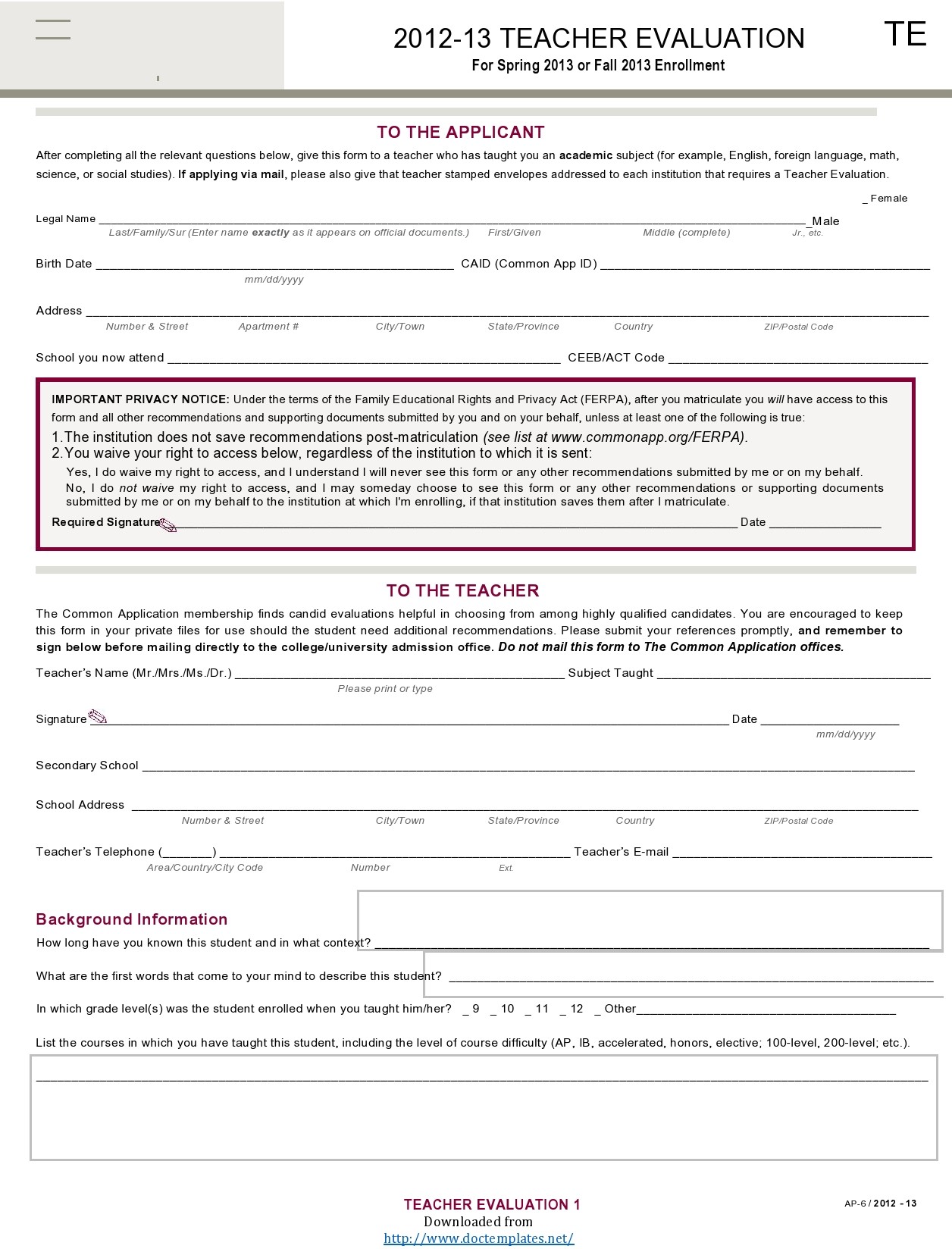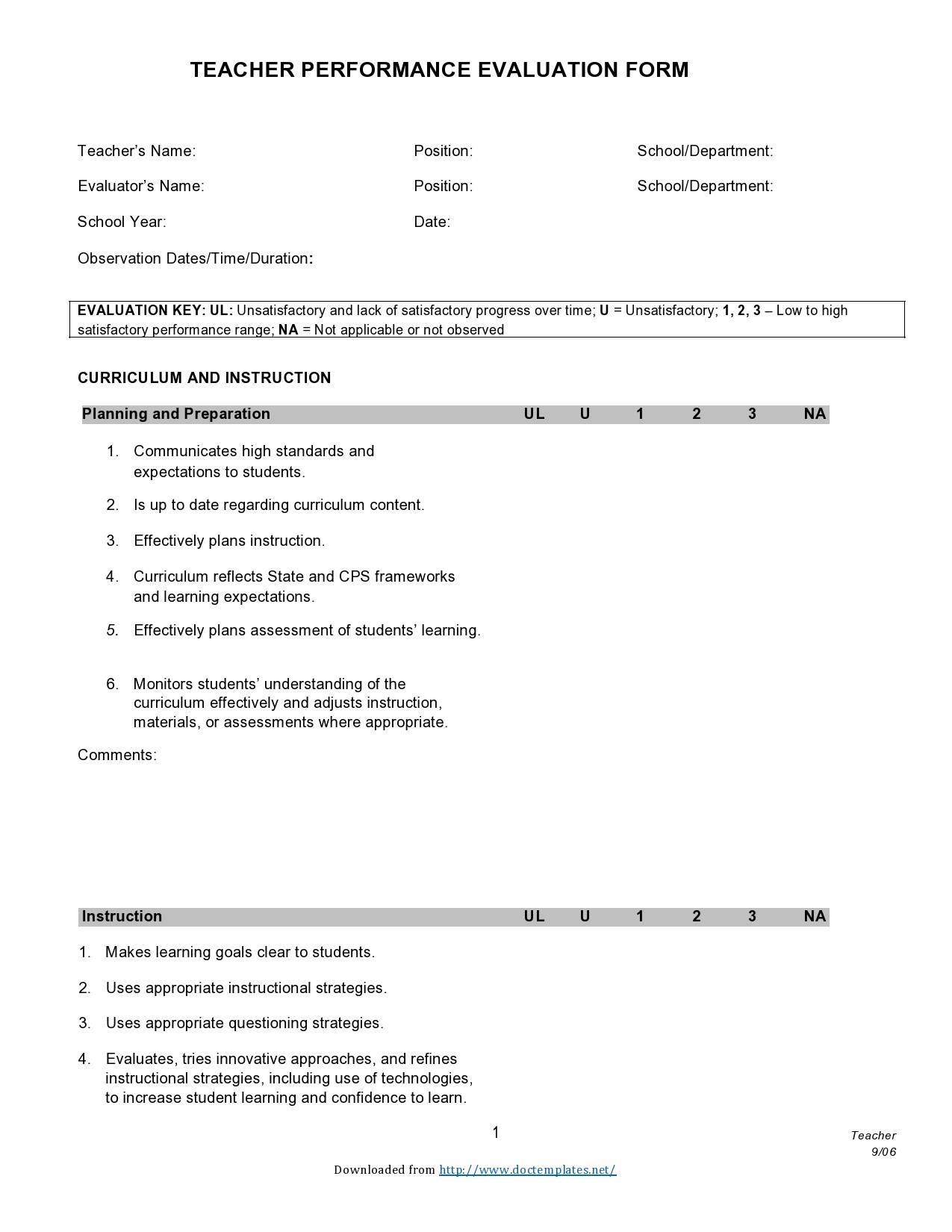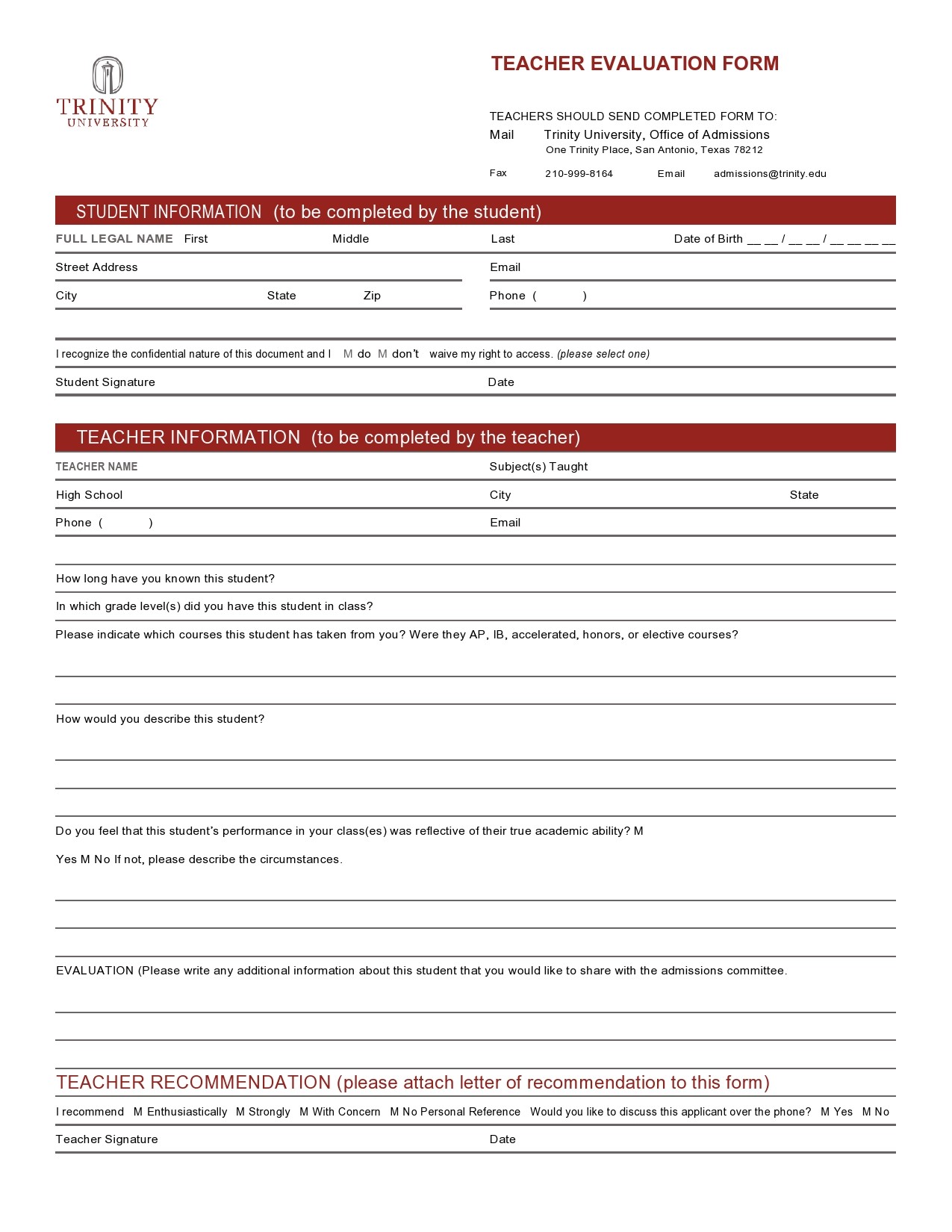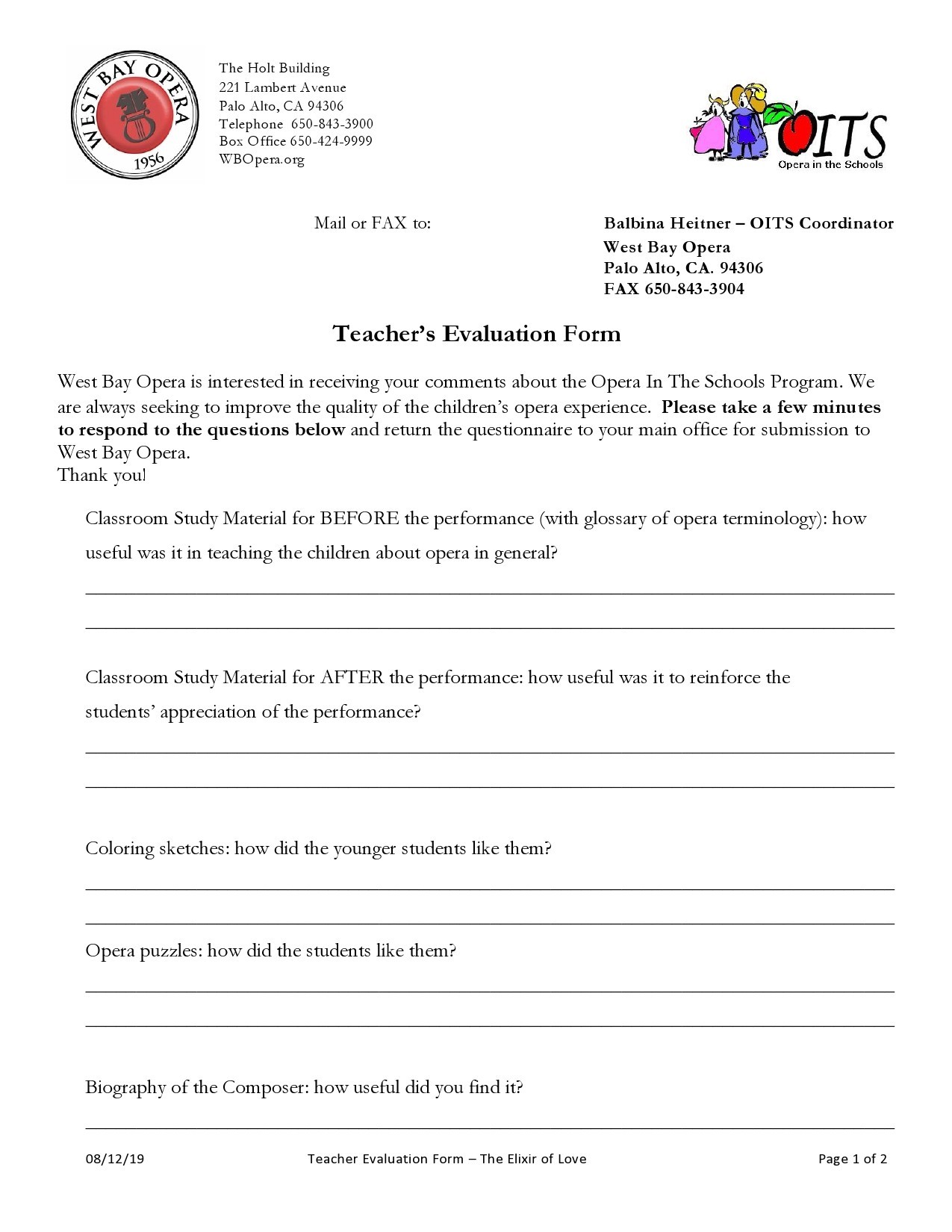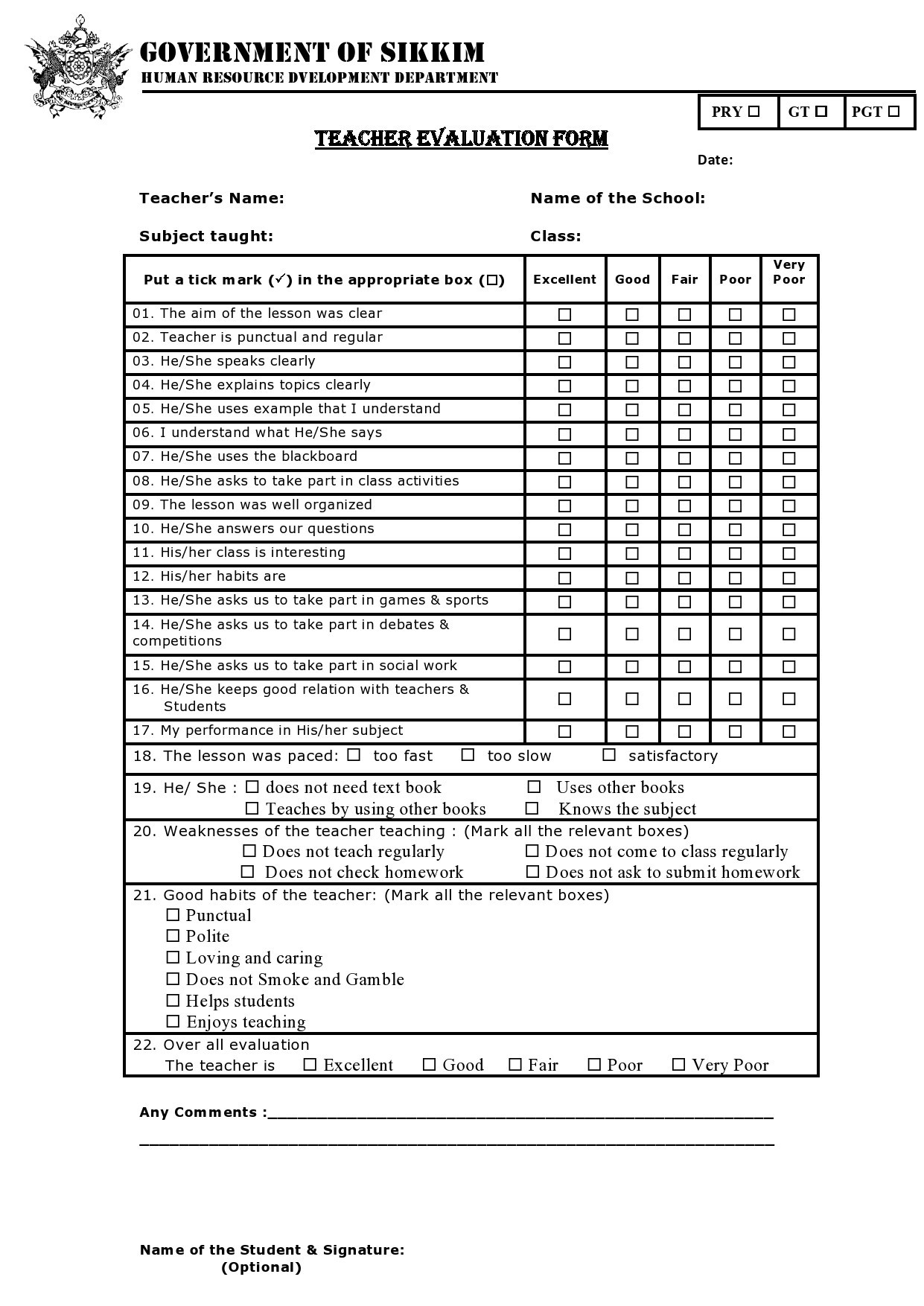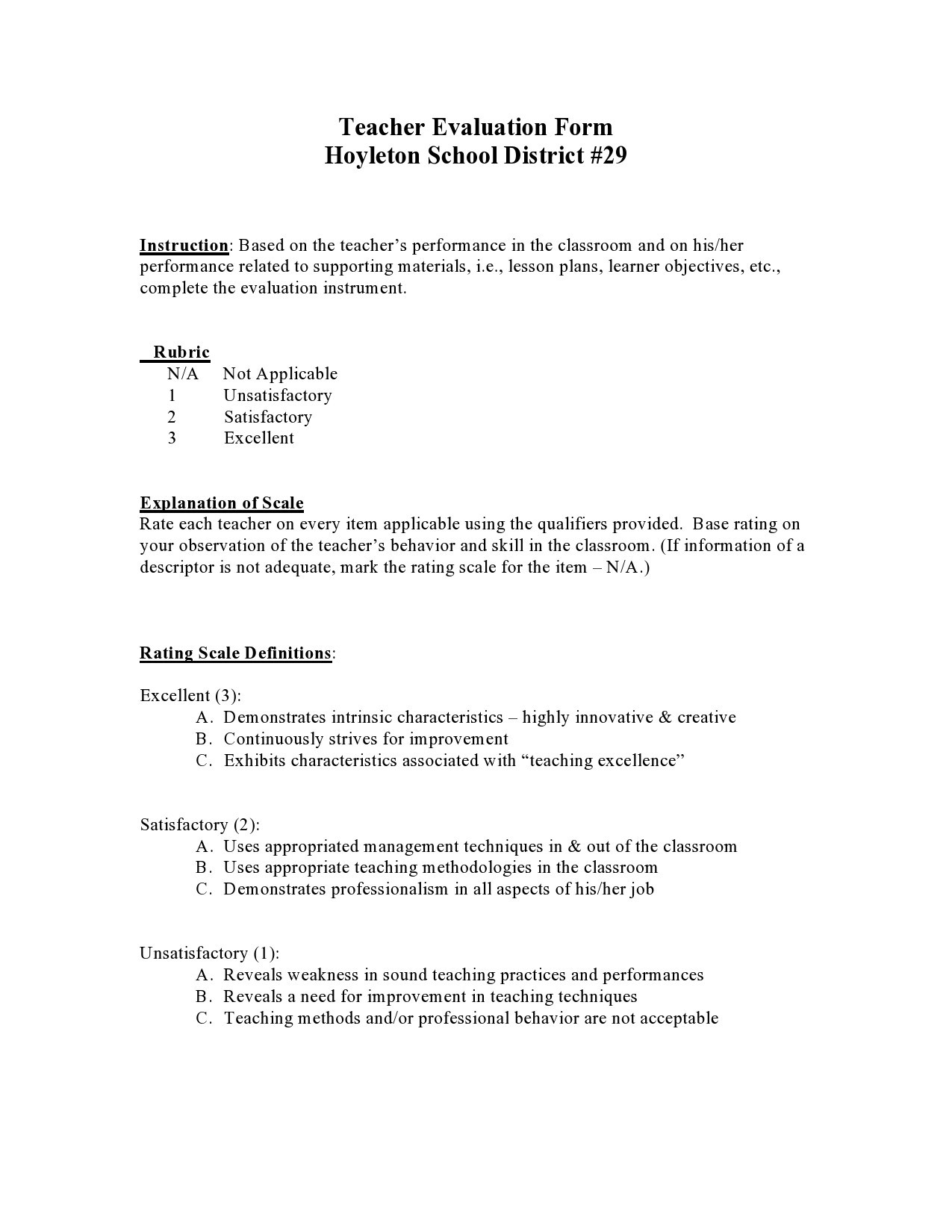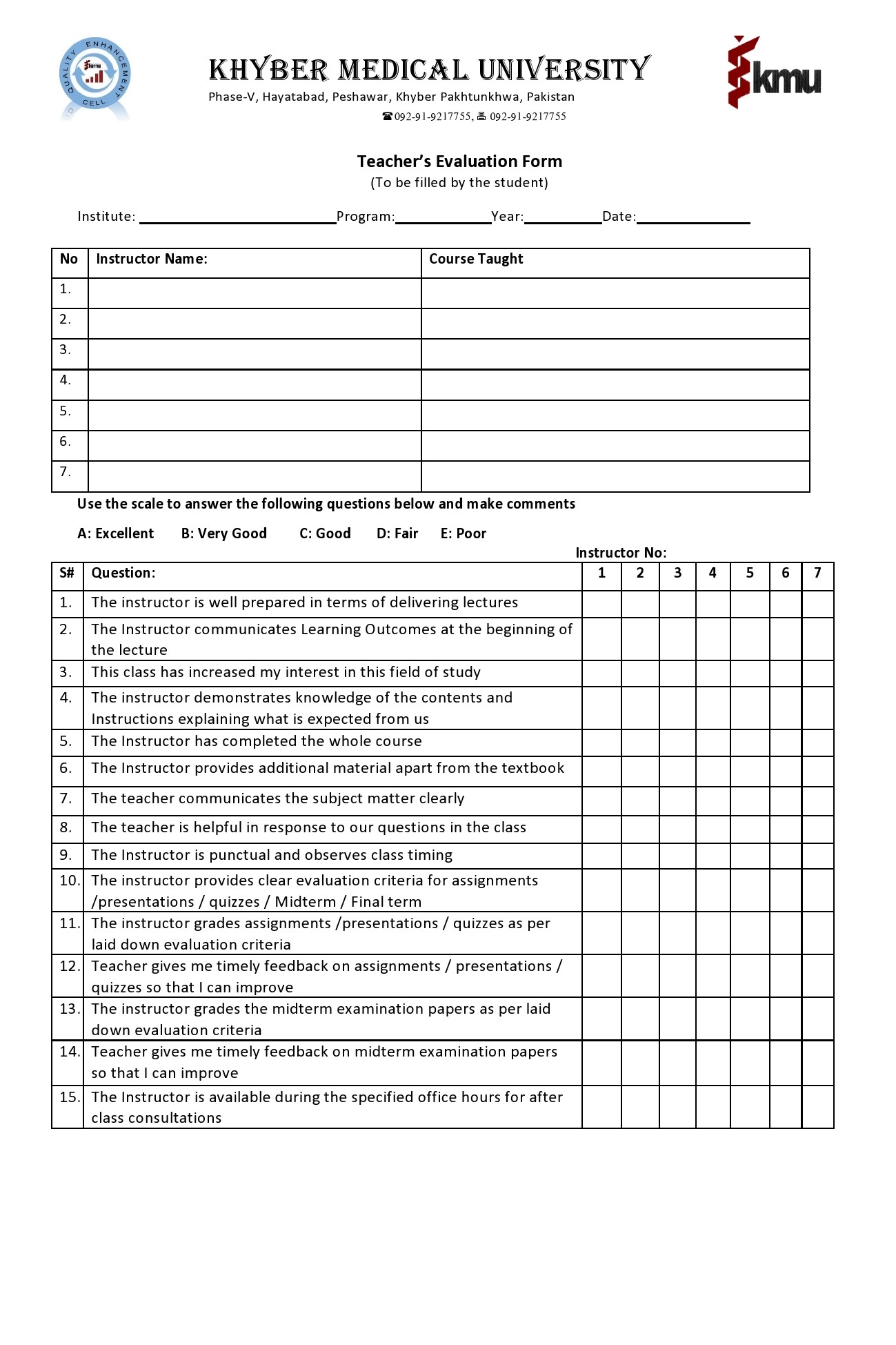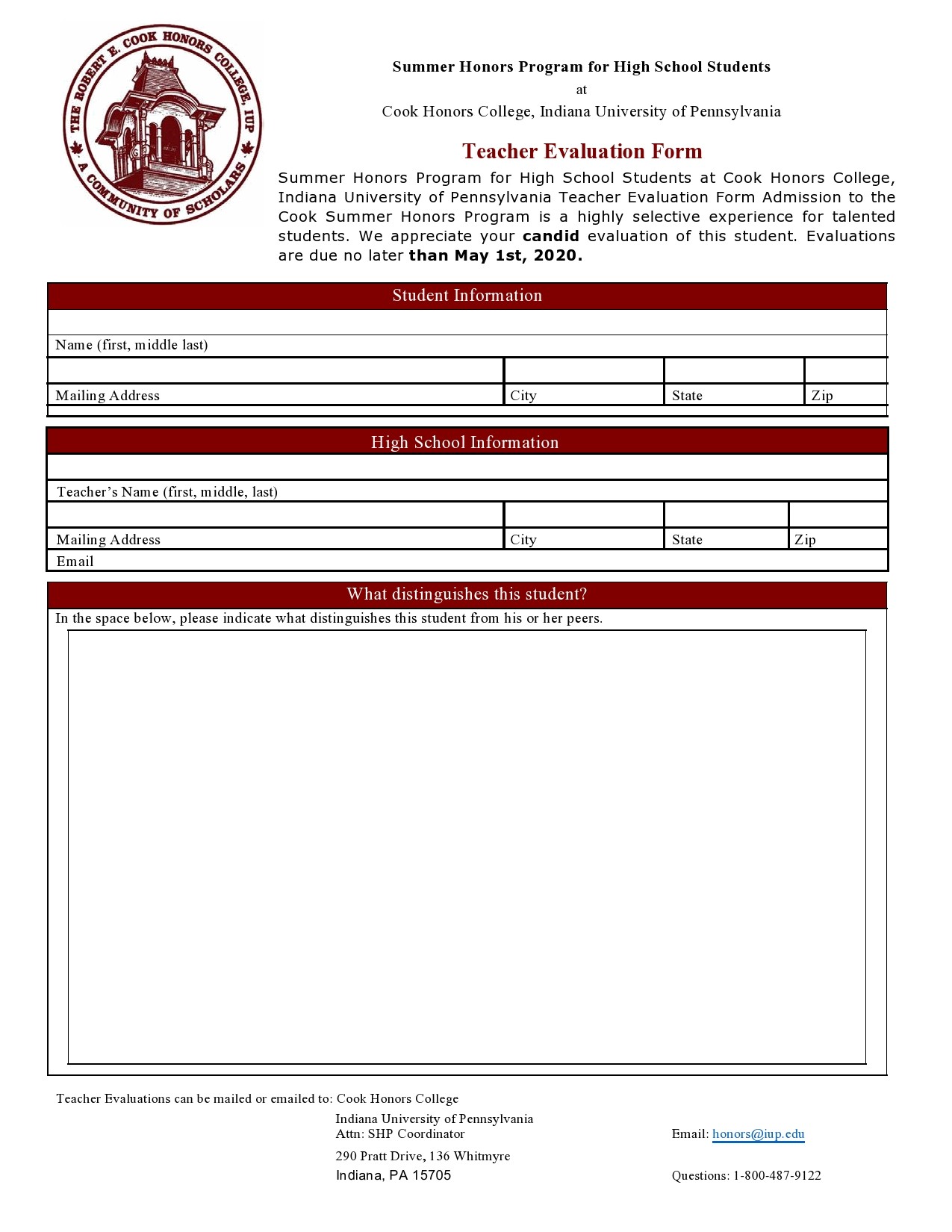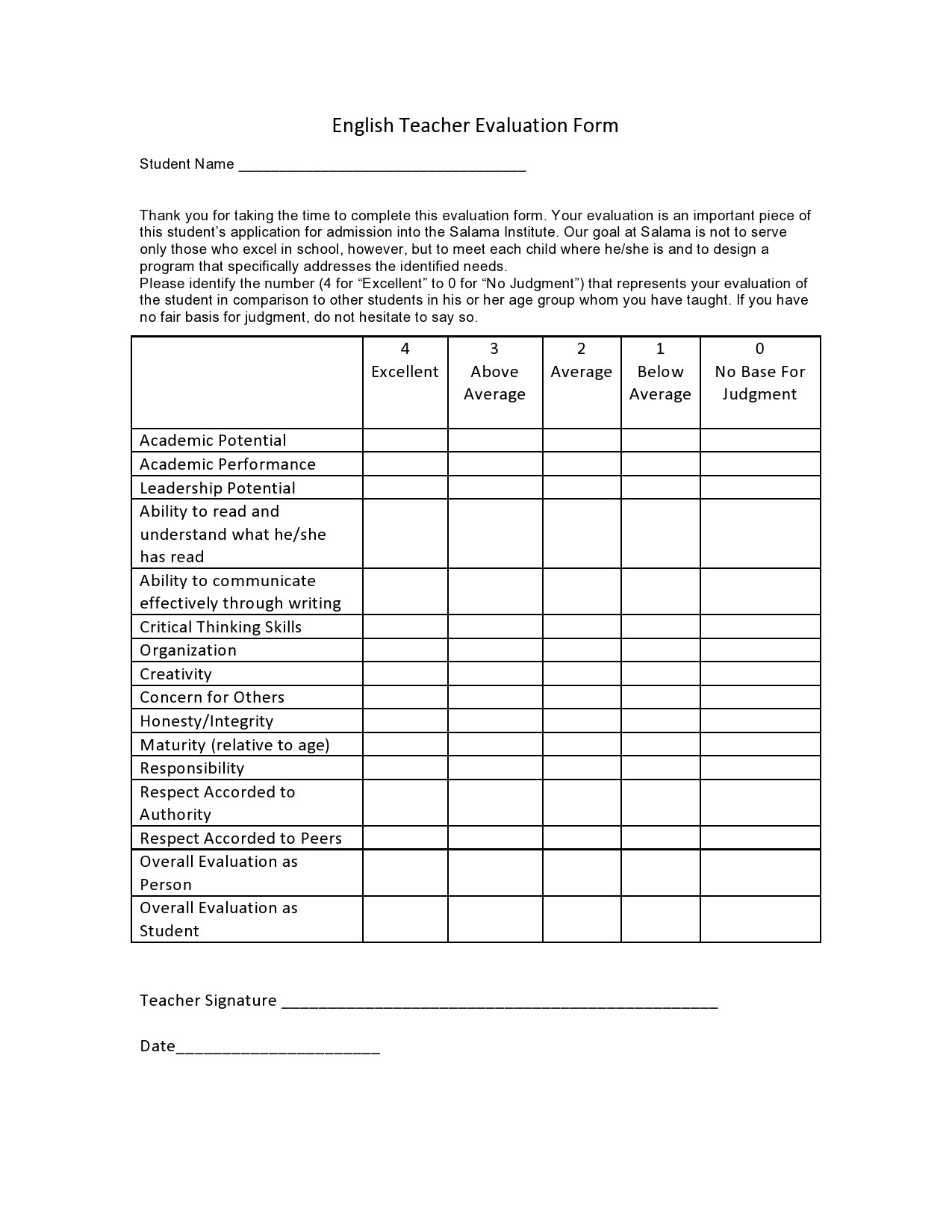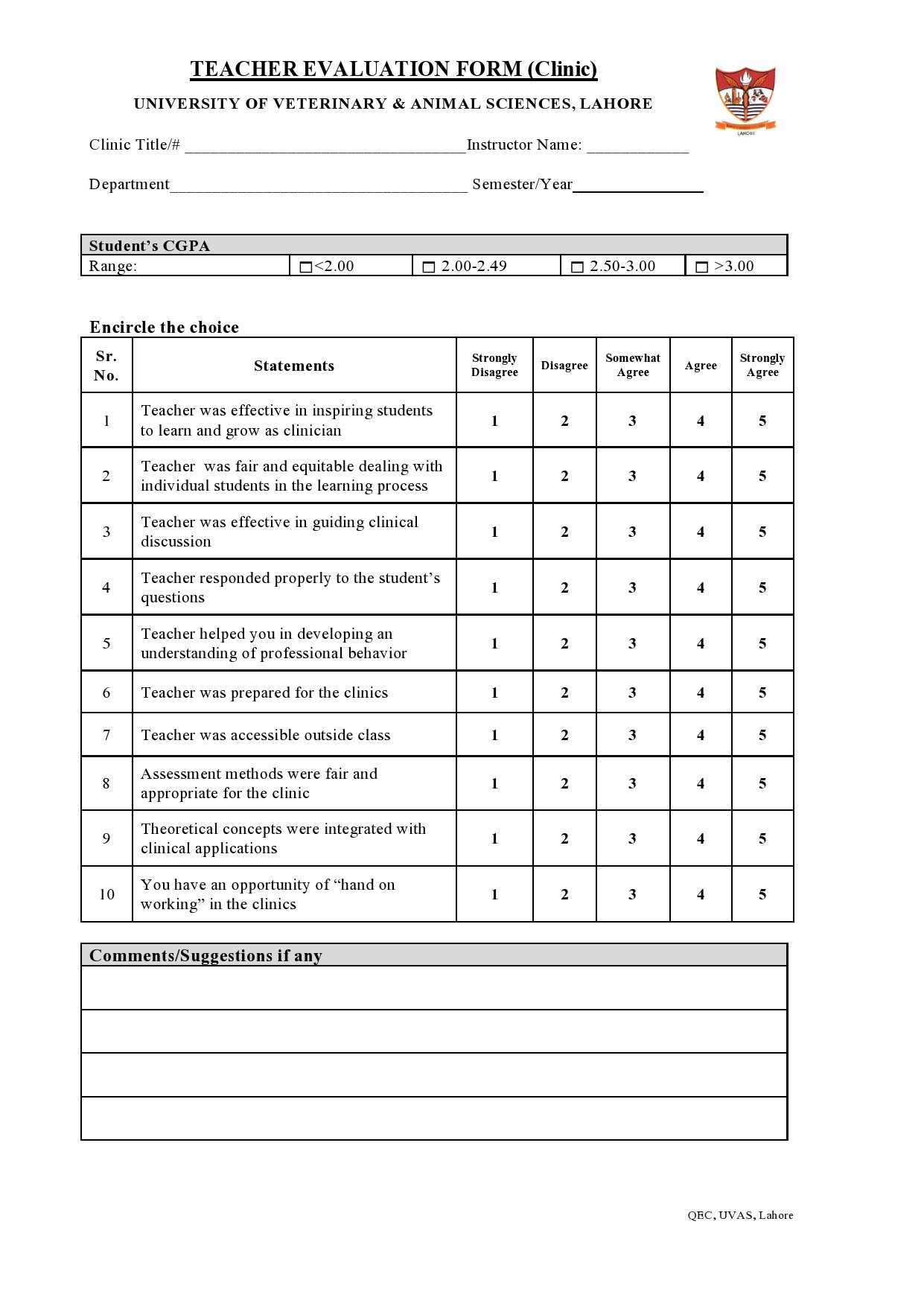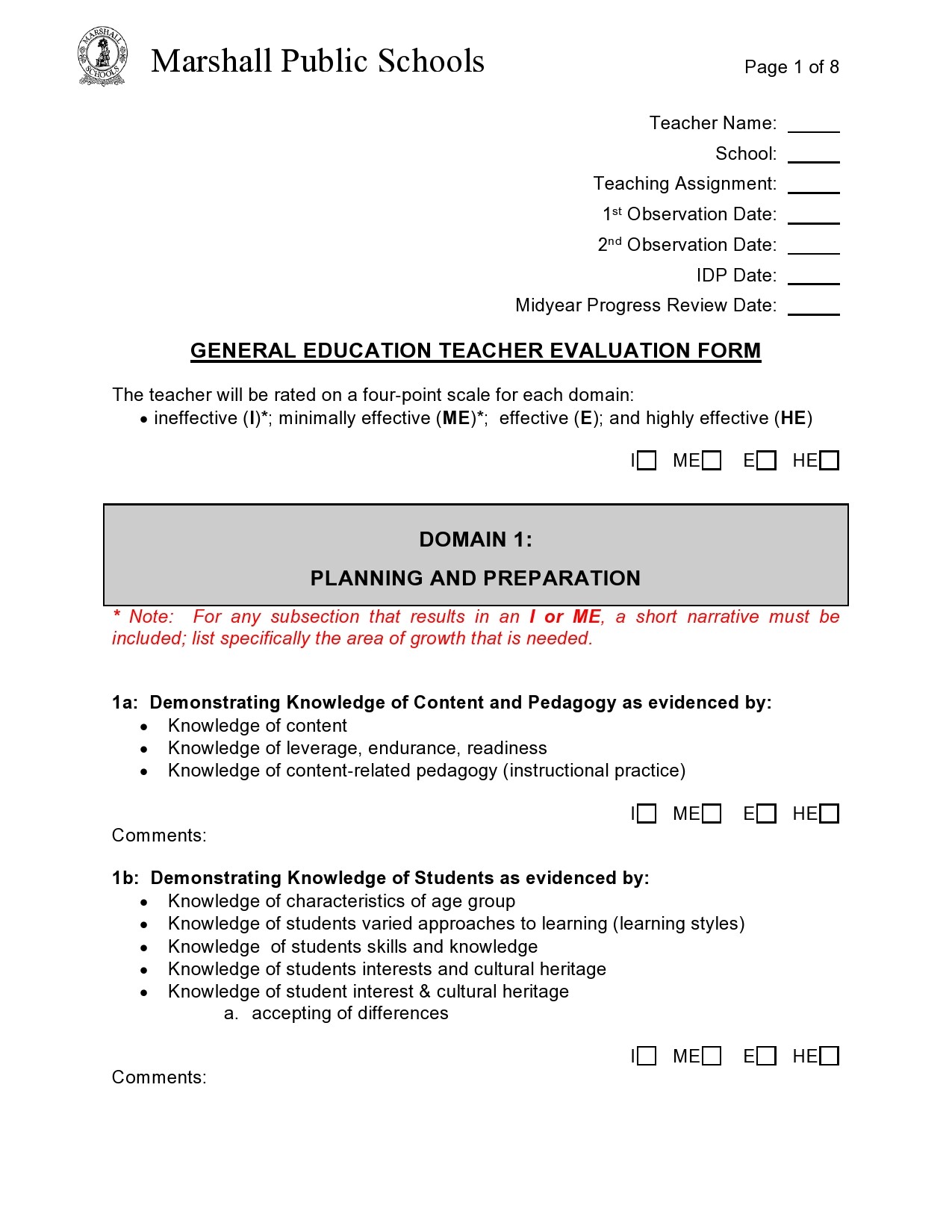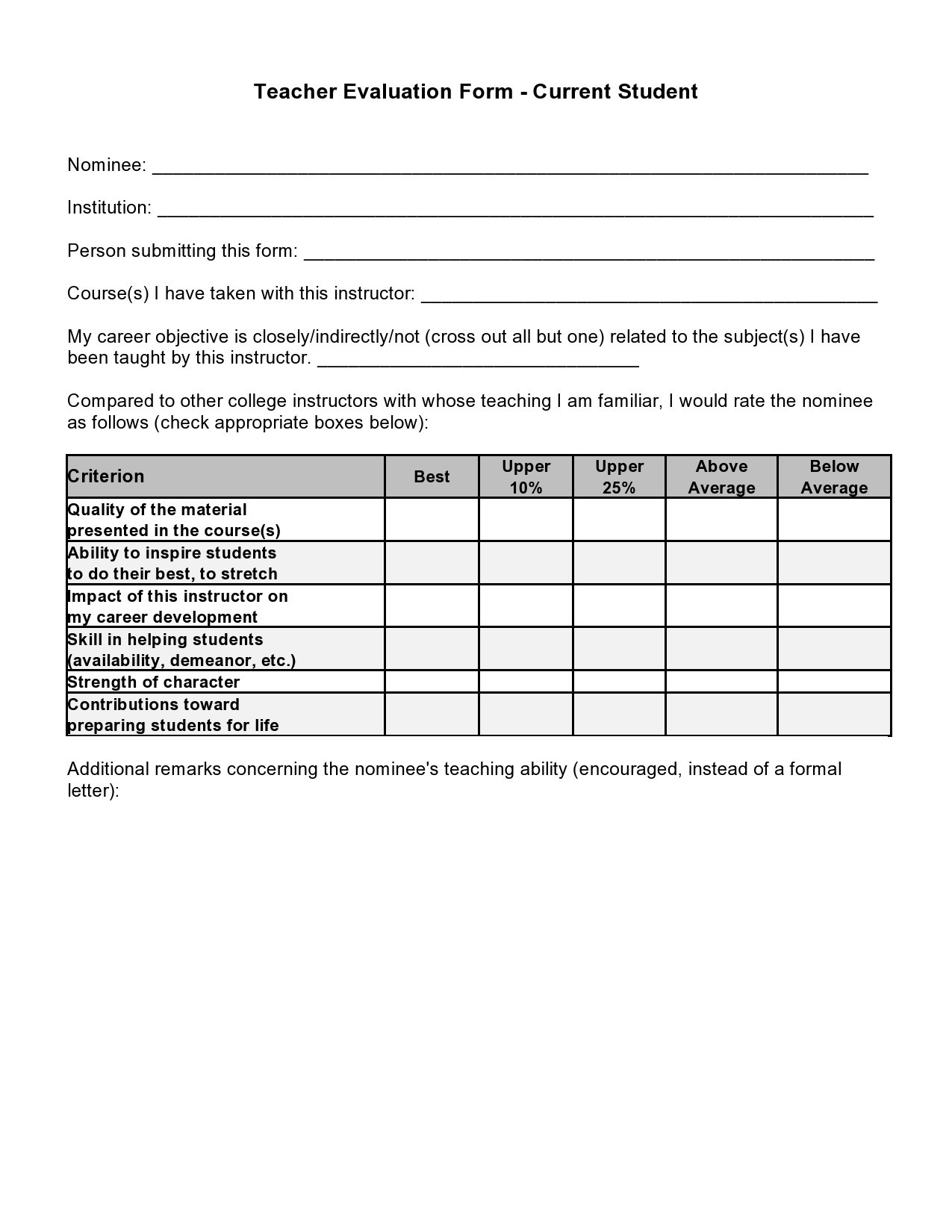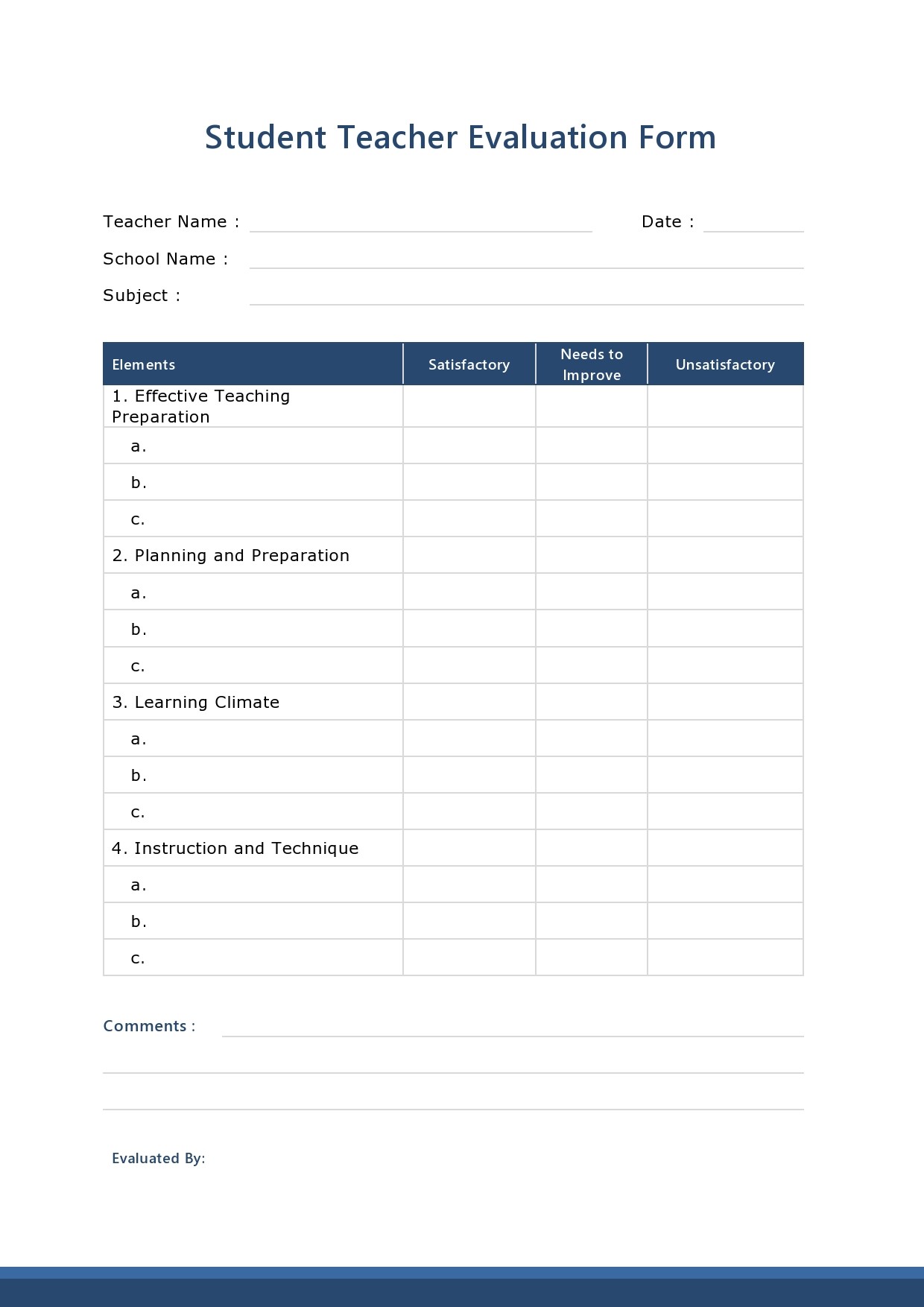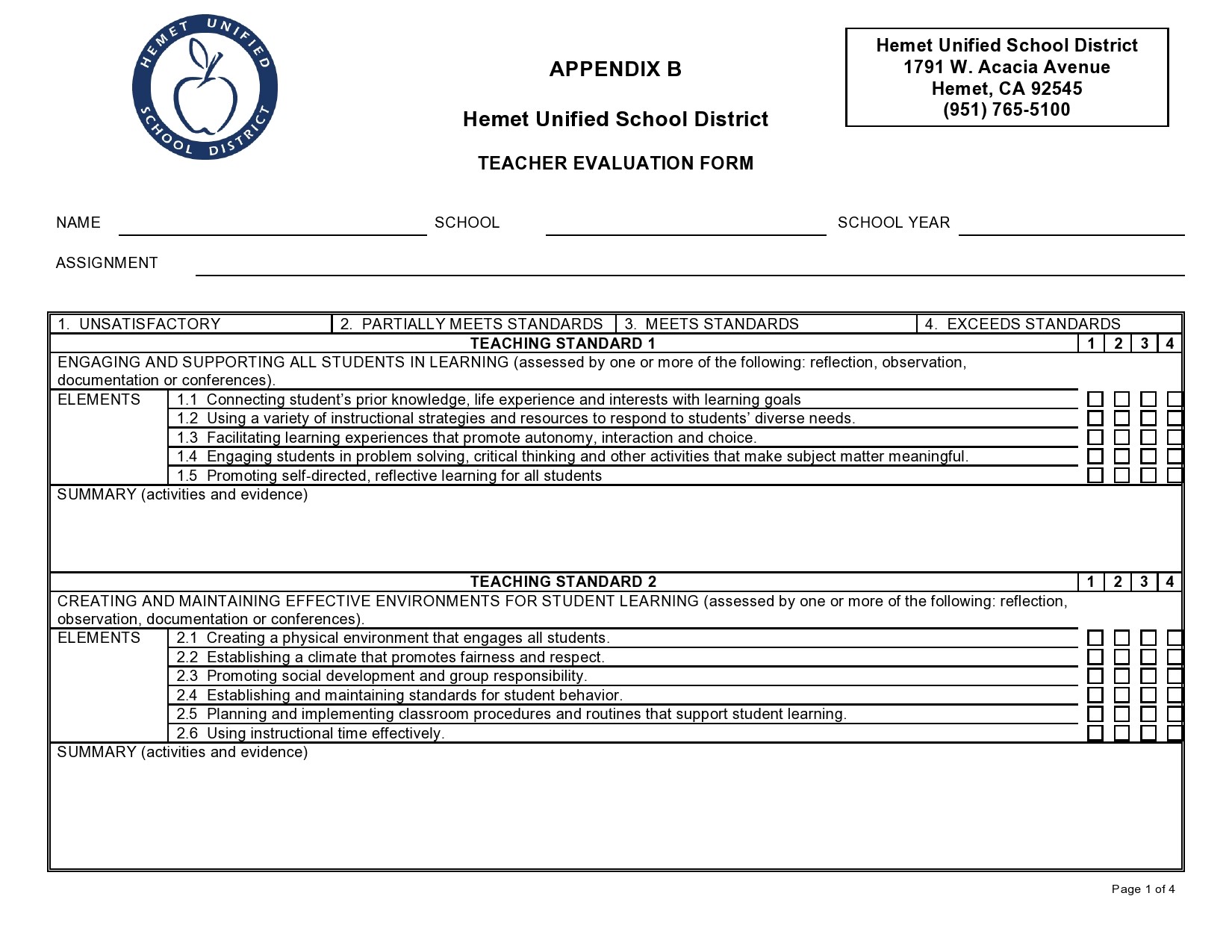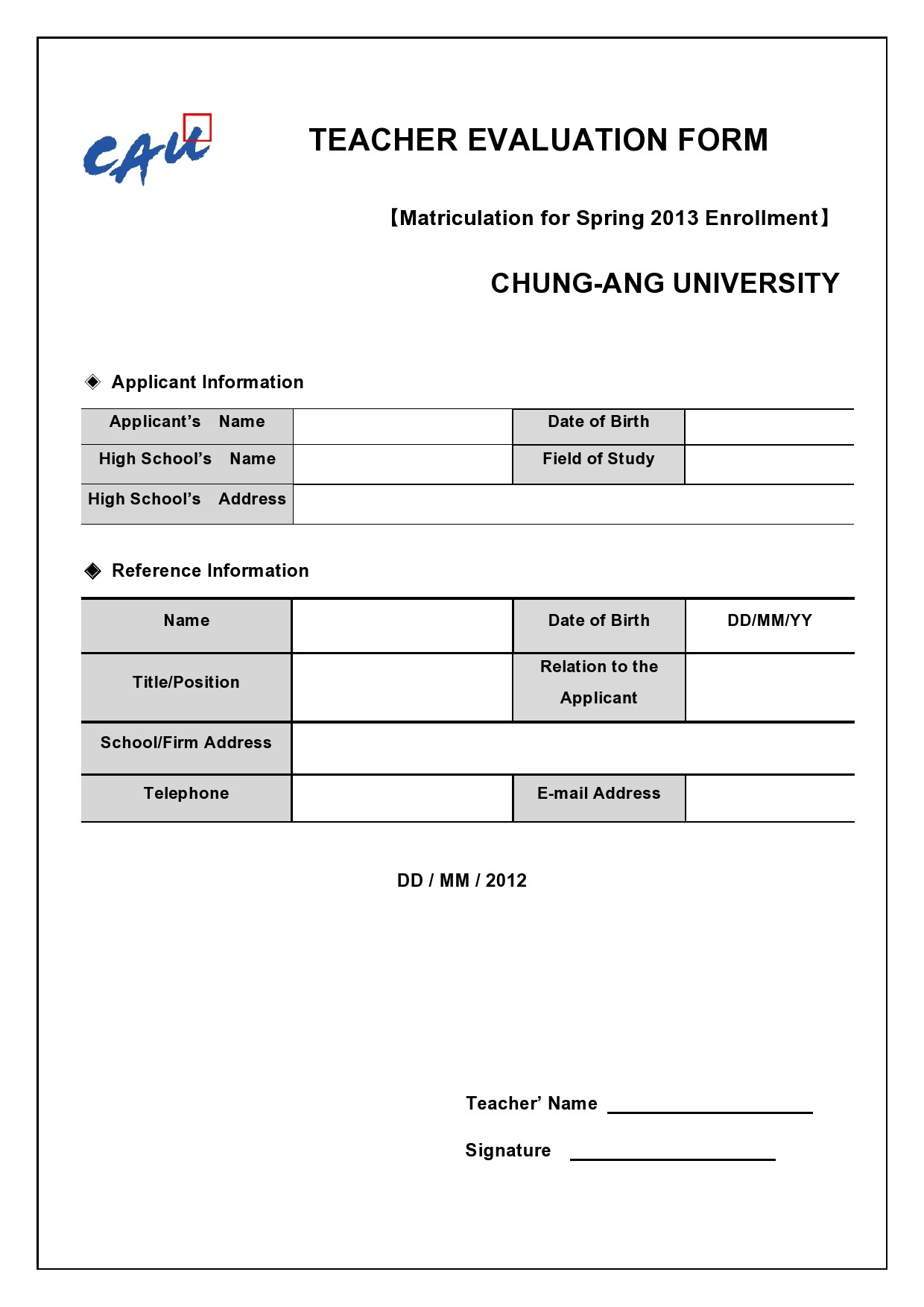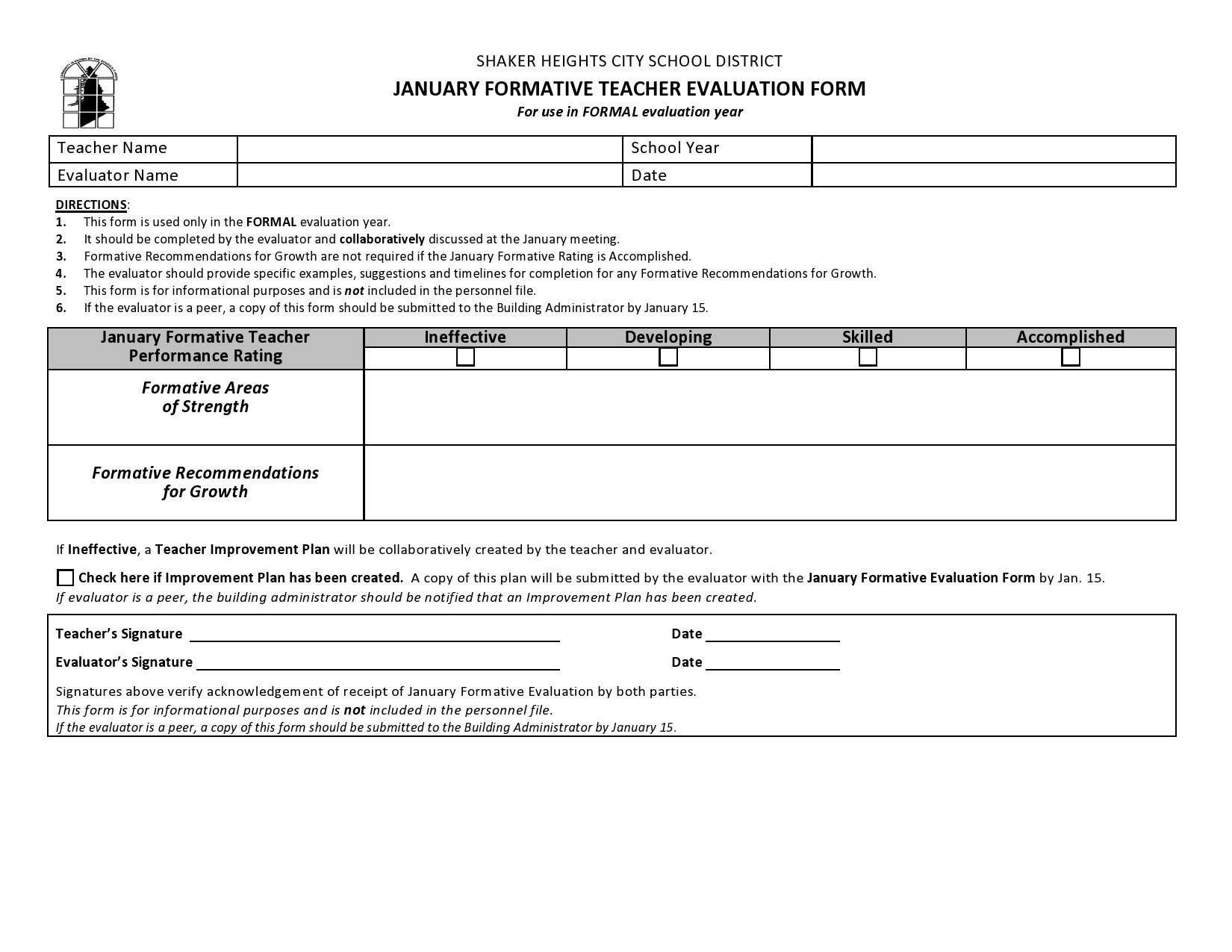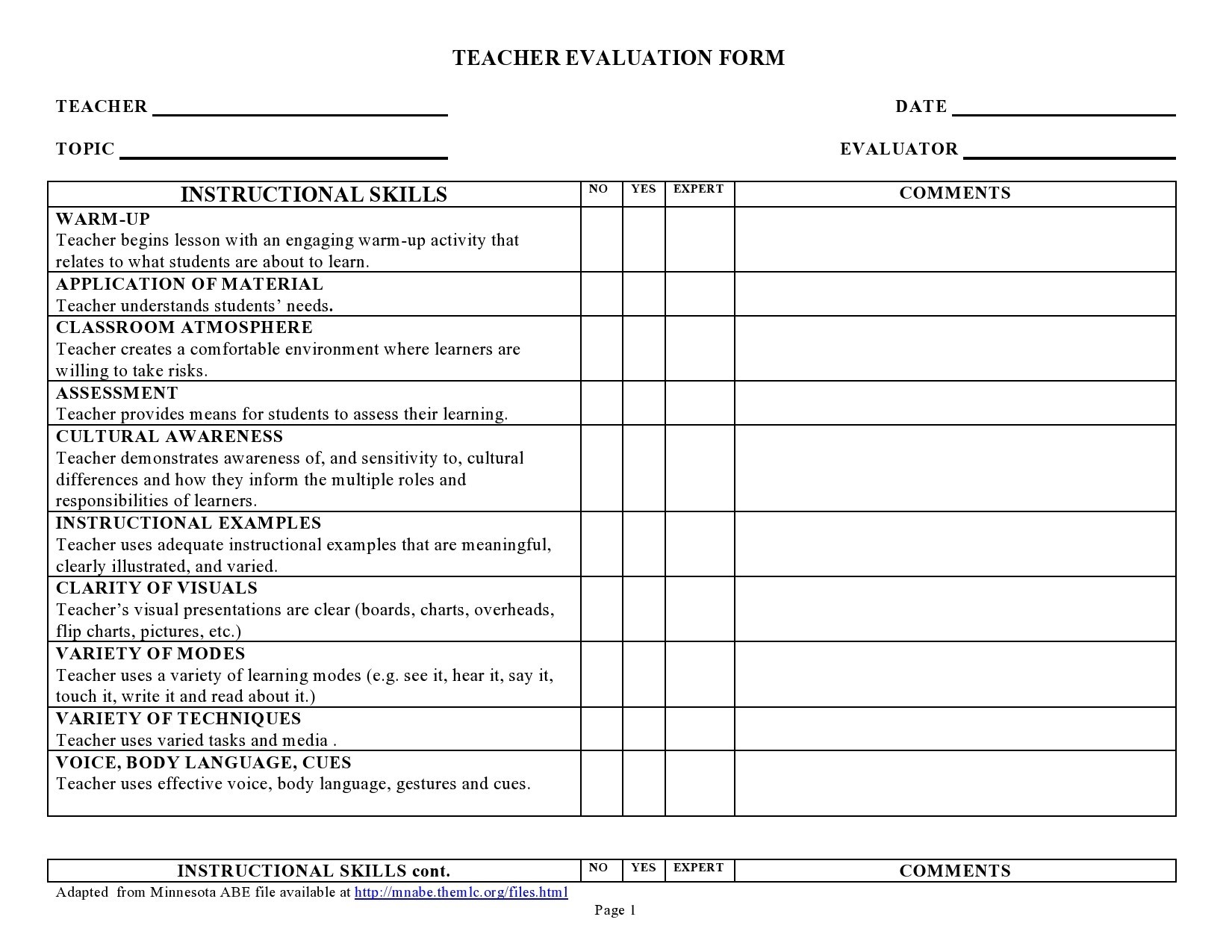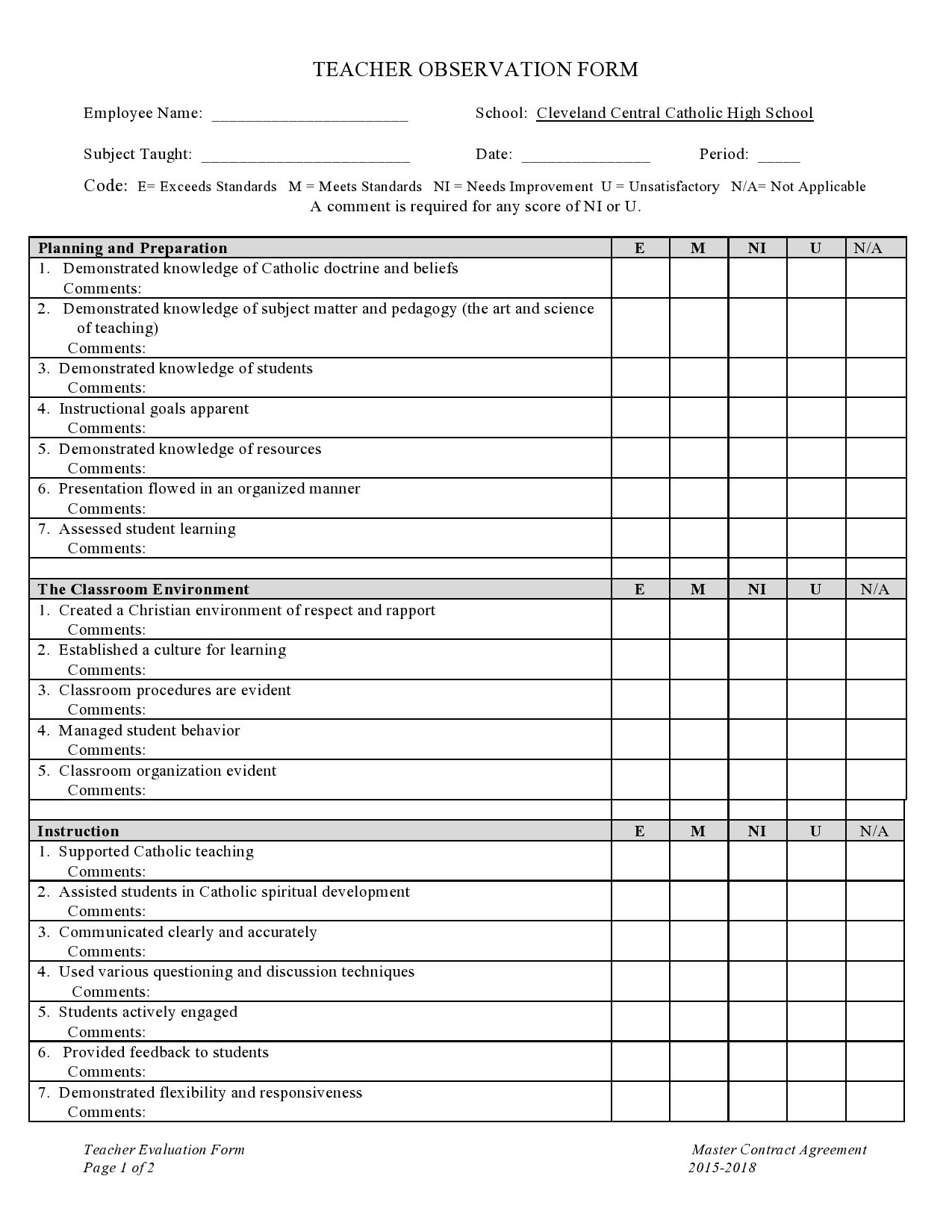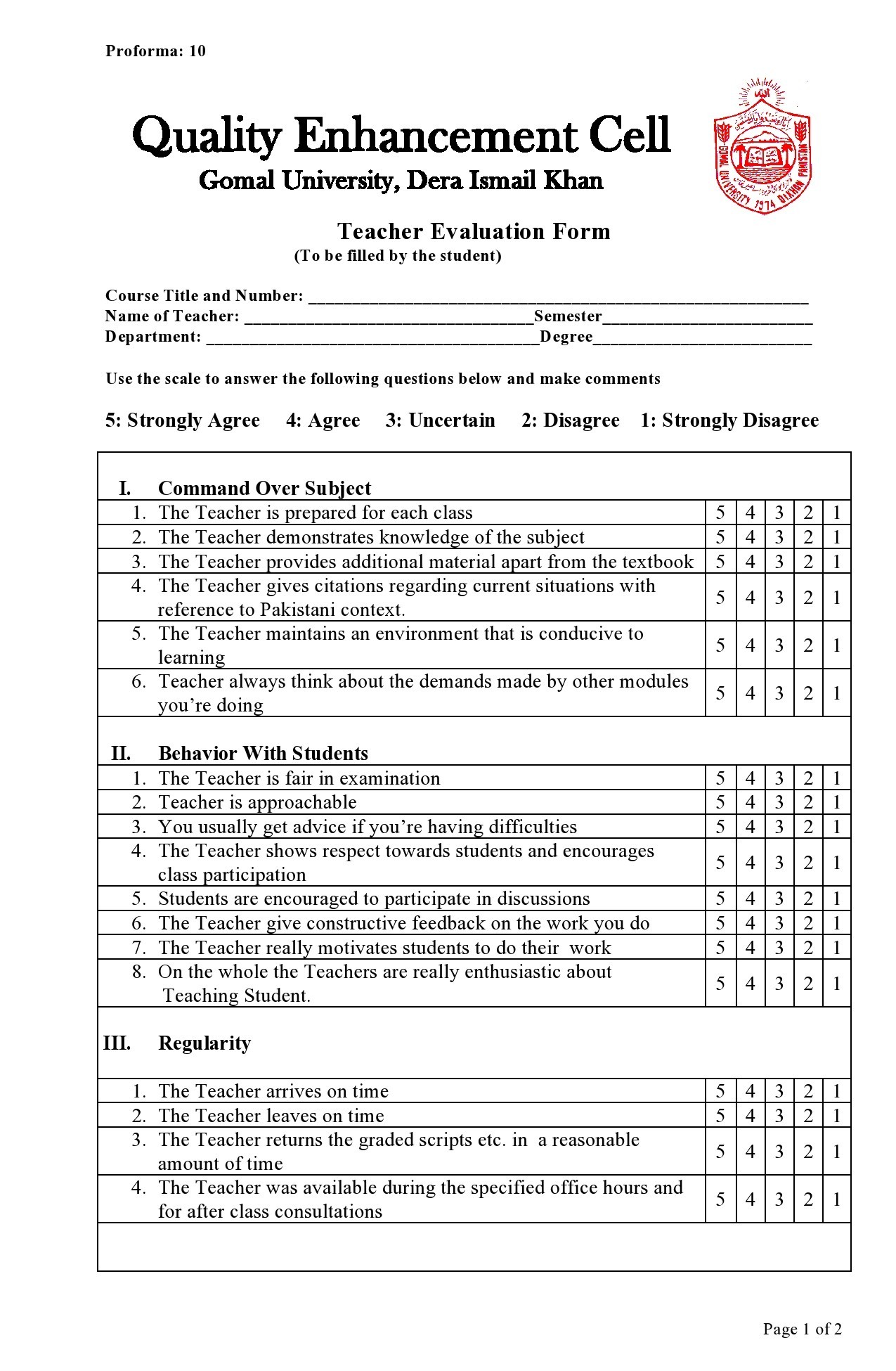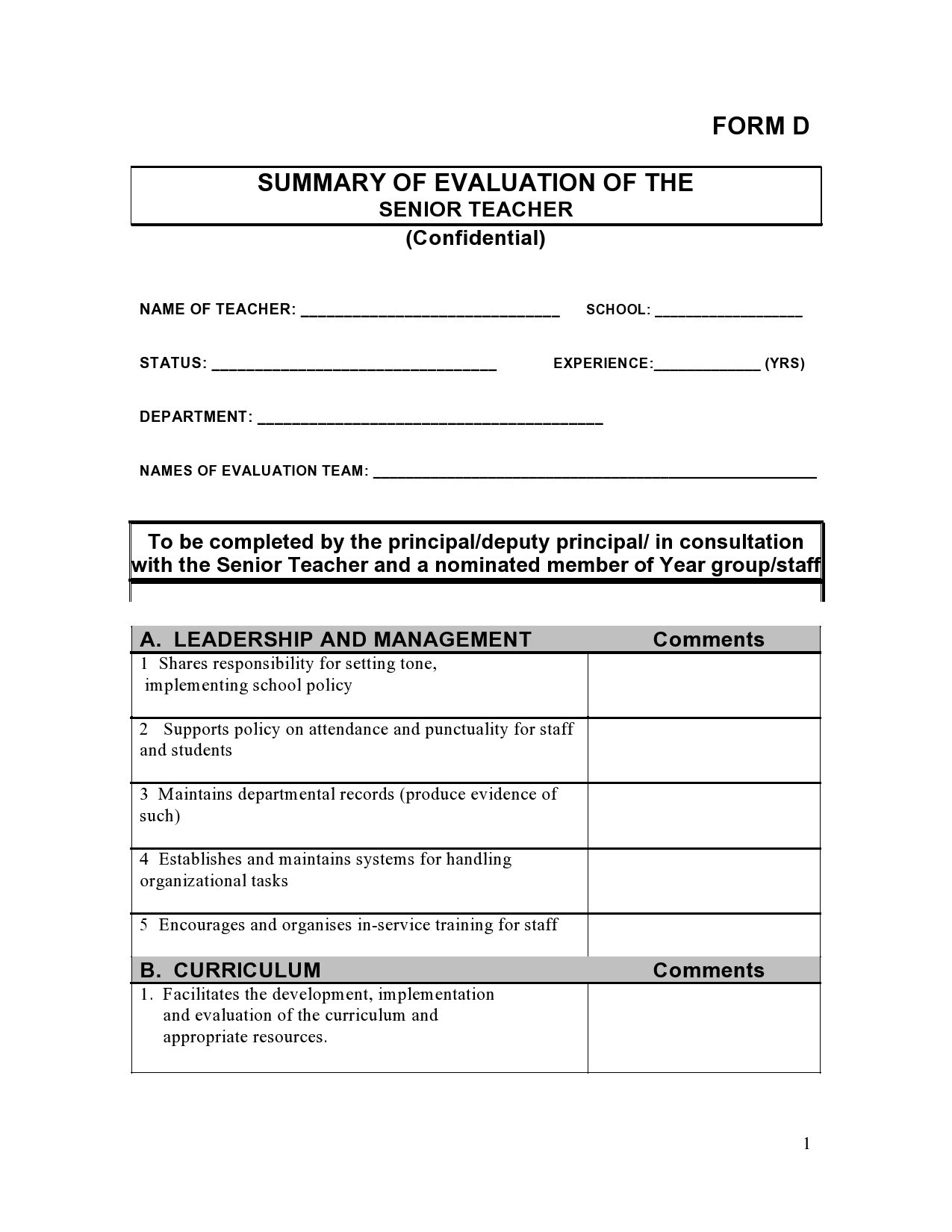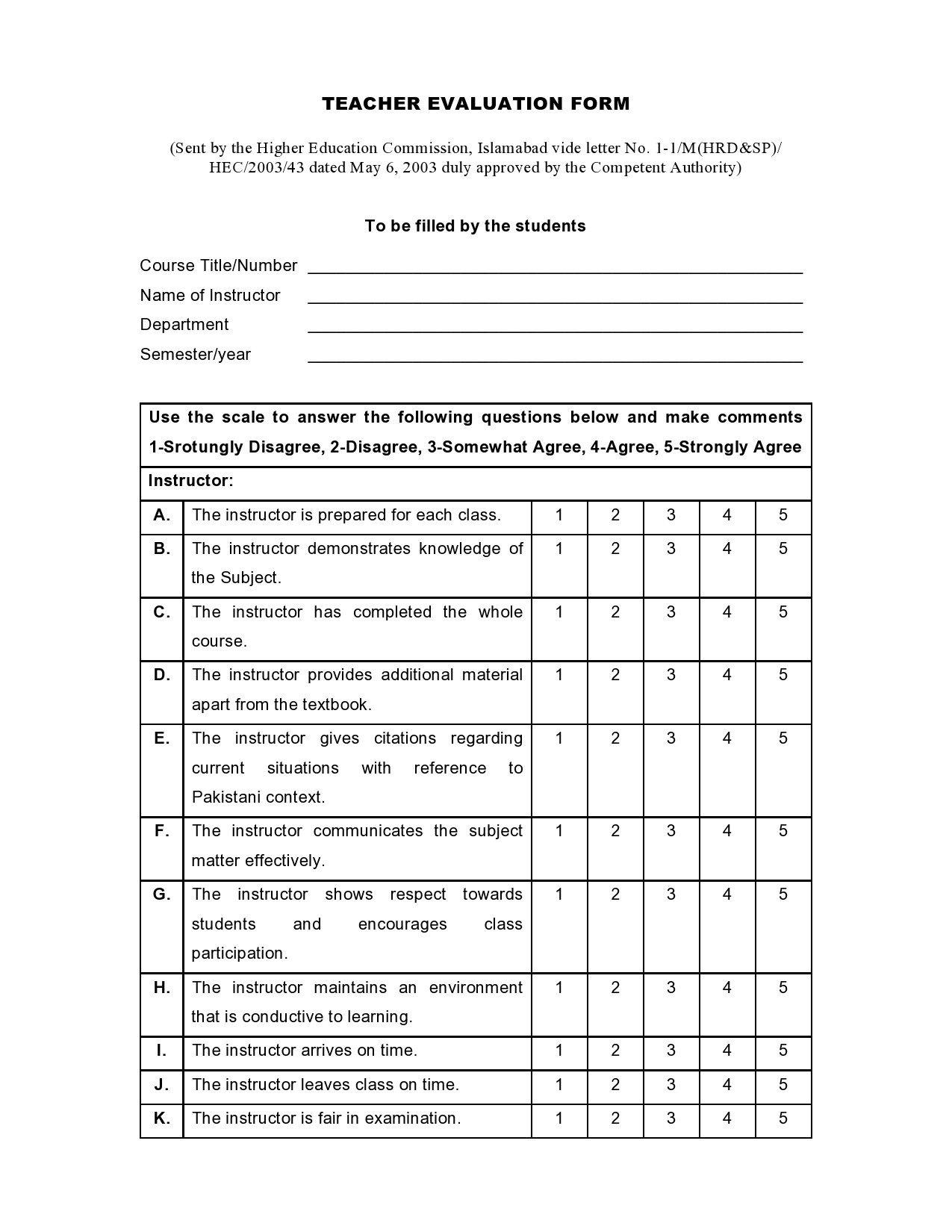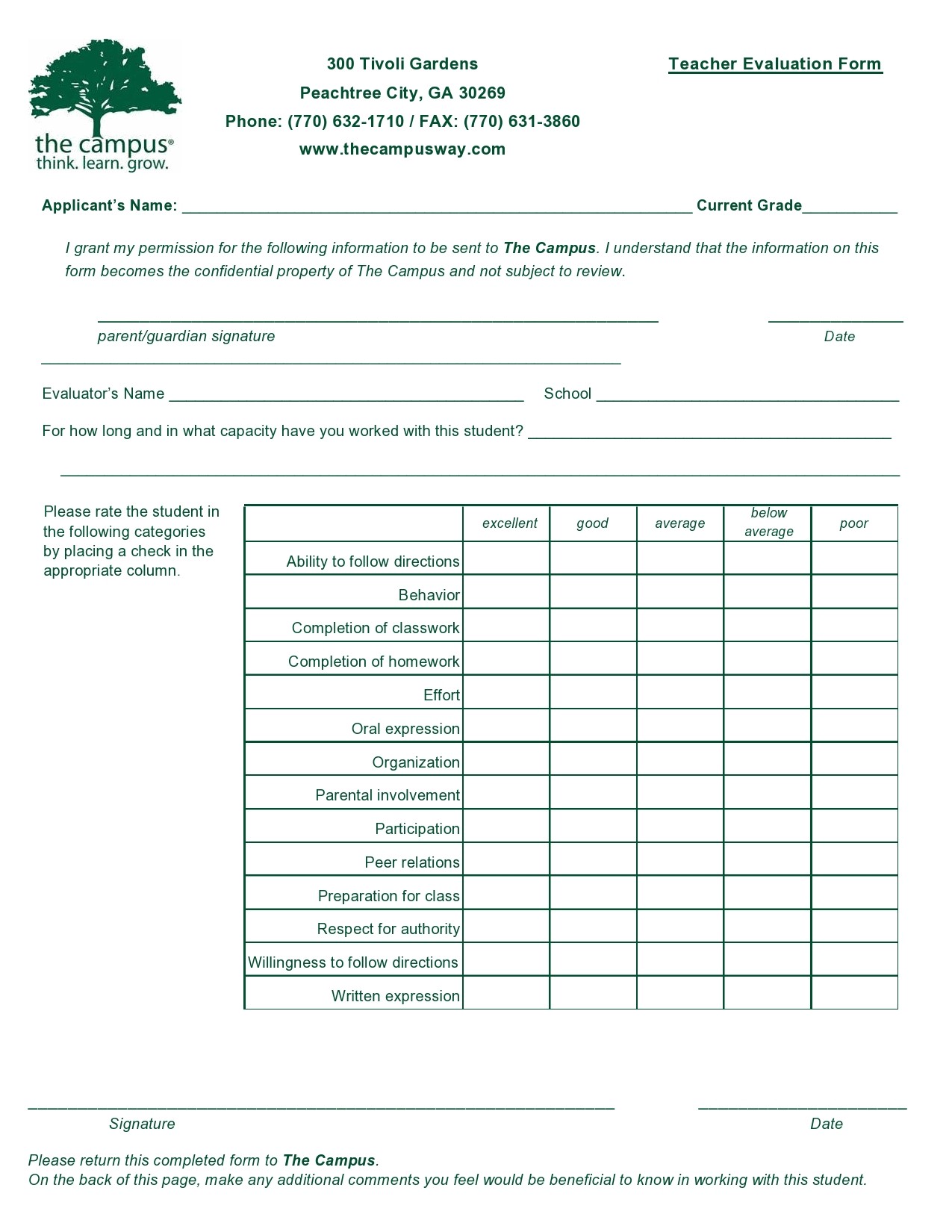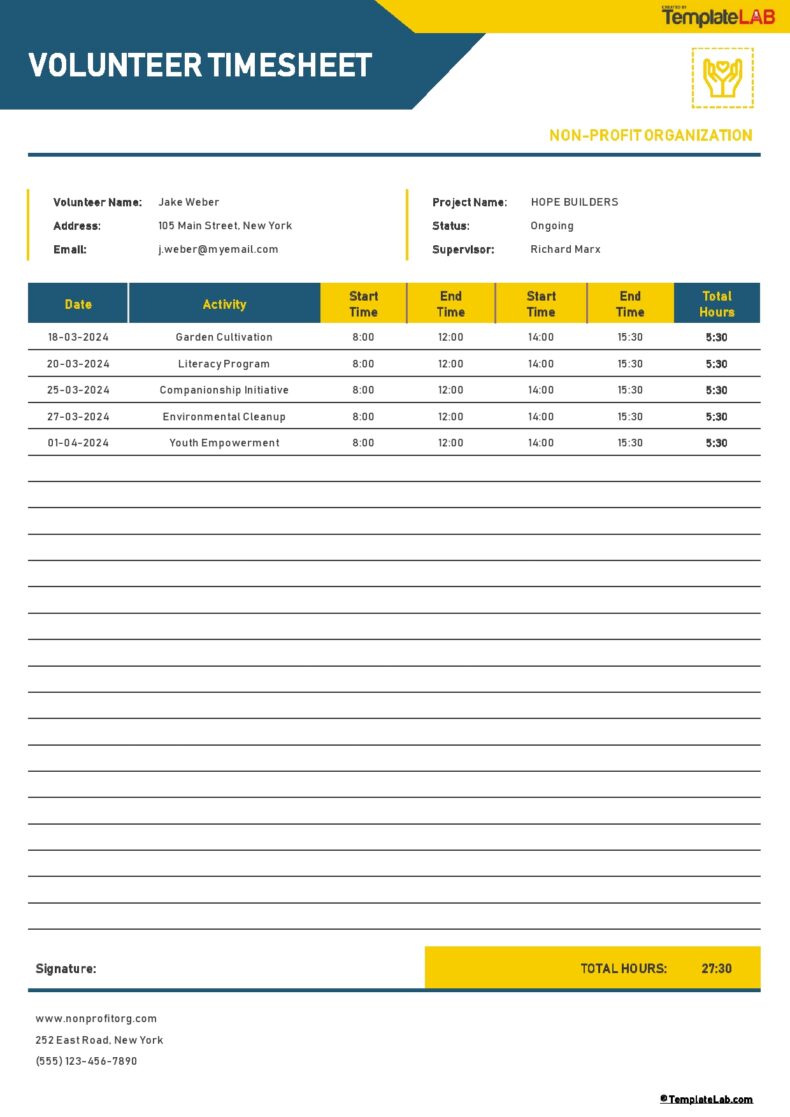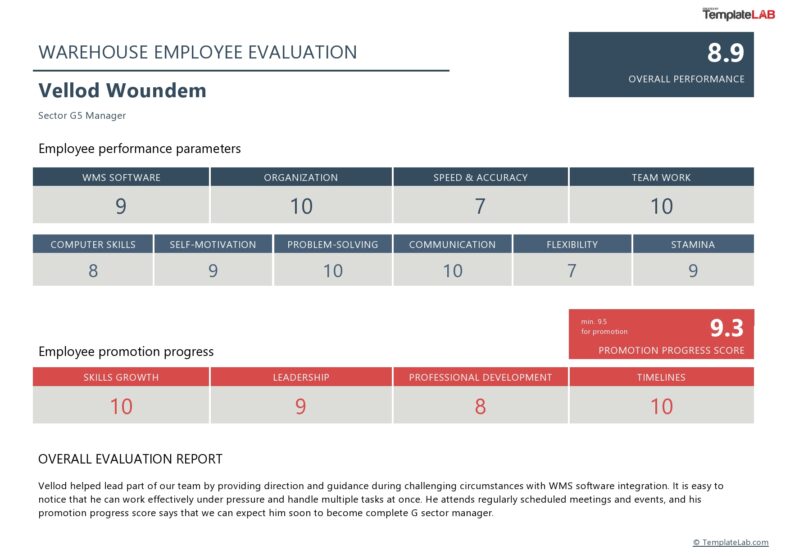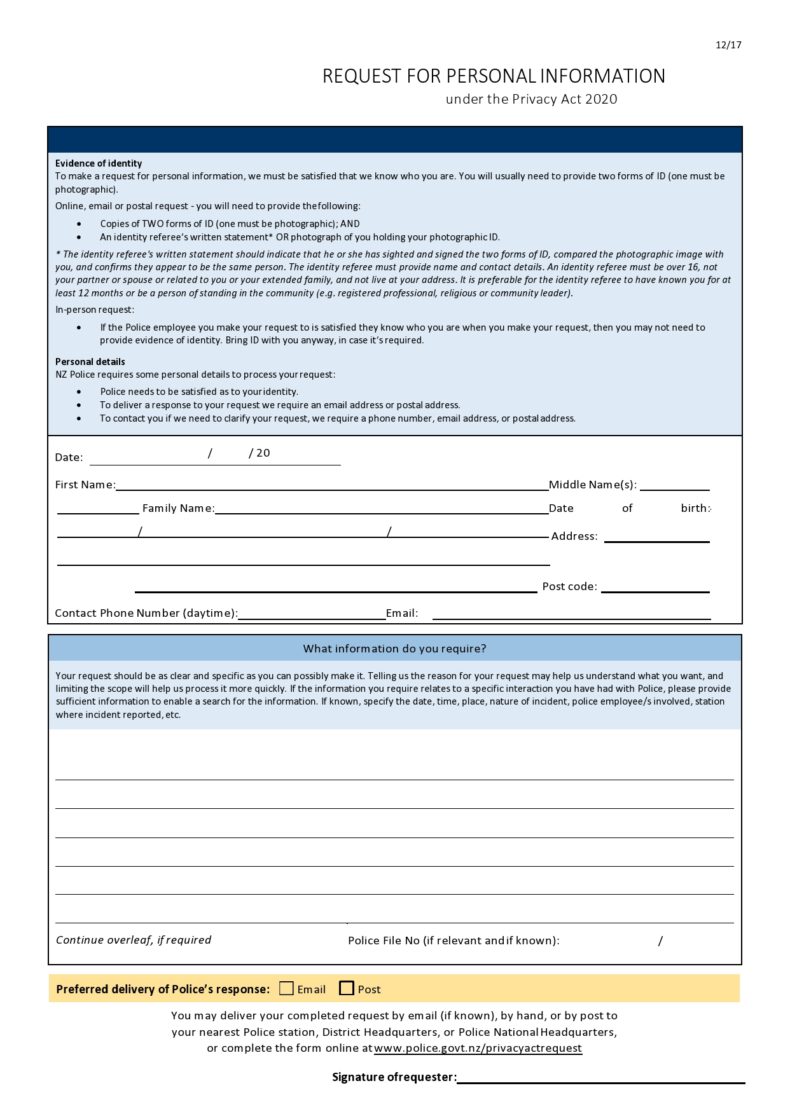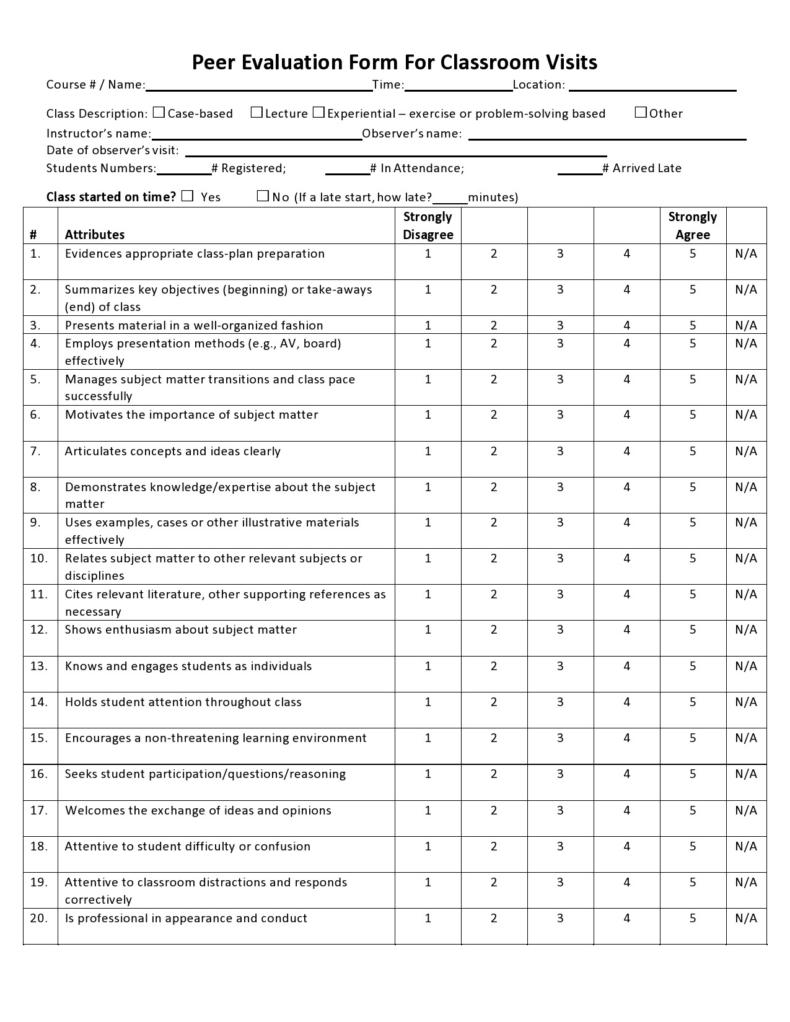Students aren’t the only ones evaluated for their performances in classrooms. Teachers also undergo such rating but the purpose is to gauge how well they create a favorable learning environment. Such an evaluation is one way to improve teaching practices in schools. You would use a teacher evaluation form to document teacher’s performance and this will be the basis for their annual evaluation and accreditation.
Table of Contents
- 1 Teacher Evaluation Forms
- 2 What is teacher evaluation form?
- 3 Teaching Evaluation Templates
- 4 What is teacher evaluation report?
- 5 Teacher Evaluation Forms For Administrators
- 6 When do you need a teacher evaluation form?
- 7 Teacher Evaluation Forms For Students
- 8 What is the Marzano teacher evaluation model?
- 9 Teacher Feedback Forms
- 10 Using a teacher evaluation form in the most meaningful way
Teacher Evaluation Forms
What is teacher evaluation form?
A teacher evaluation form is a document used to review the performance of teachers in the classroom. You can also use a teaching evaluation template to analyze the review and provide helpful feedback for the professional growth of teachers. Teacher feedback forms vary for each district as different state laws govern them.
Traditionally, the administrative staff and principals use a special teacher evaluation form for administrators during this process. They consider different aspects when evaluating teachers and these even include student performance and other aspects like records maintained, classwork, lesson plans, and others. Teacher evaluation is one of the most important components for a teacher’s development and is also vital in maintaining the quality of education.
Teaching Evaluation Templates
What is teacher evaluation report?
Teachers get evaluated annually for their performance inside the classroom and the results get recorded in a teacher evaluation report. This is a formal document that the school uses to evaluate and come up with a rating for a teacher’s effectiveness and performance. Ideally, the results in these reports provide valuable feedback to teachers to guide them in their professional growth and development.
Teacher evaluations are carefully designed and used at district level. They can widely vary in their requirements and details. The use of teacher evaluation form for administrators and teacher evaluation form for students rely on classroom observations performed by school administrators or the principal. In some schools, students also get the chance to evaluate their teachers.
Teacher Evaluation Forms For Administrators
When do you need a teacher evaluation form?
When education reforms became one of the most significant aspects of work in the educational system, teacher evaluations started to gain momentum. Recently, many new methods for teacher evaluation have emerged to enhance the performance and efficacy of teachers. Teacher evaluation forms can have several purposes:
- For the evaluation of teachers’ performances
Teacher evaluation and teacher feedback forms are documents you use to evaluate how effective the strategies used in the classroom are. Teachers can have their own teaching strategies, most of which work towards one important goal – to enhance the student’s learning.
Should a teacher use a strategy or method that proves successful in the classroom, this strategy needs evaluation to find out its effectiveness as a teaching strategy. Teacher evaluation templates are readily available online. You can also create your own template, where you include all the information you want to learn about the teachers in your school. - To find out what motivates teachers
One of the crucial points in an educational system is that you always want to guarantee that you work with the best people in your school. You can attain this in part if you have a comprehensive plan for evaluation that you conduct every month or every semester.
There are several reasons why this process is necessary, most important of which is that it helps you as an evaluator know if the teacher you’re evaluating performs well in their assigned position. It’s not enough to say that the teacher does their job effectively just because they go to class each day. - Other purposes
The school management is in charge of the continuous growth of its teachers. As such, the most important purpose of performing teacher evaluation is for the empowerment of all teachers who impart education in the best and most effective way. The other important purposes of evaluation include:
Assigning the teachers in positions based on their respective contributions and abilities.
Unproductive teachers can get the choice to resign or perform better while efficient teachers can move forward in their careers.
The feedback gathered helps make well-informed decisions about promotions and appraisals.
You need to make sure that teachers are always kept satisfied so they can perform better and retain their positions. The school administrative system can resort to a teacher evaluation form to help understand the factors that have an effect on how productive teachers are.
The same document can also provide insights into the areas that need improvement and areas where everything works well. The data gathered in the teacher evaluation form enables colleges and schools to make decisions to improve retention, lessen teacher attrition, and enhance job satisfaction.
Teacher Evaluation Forms For Students
What is the Marzano teacher evaluation model?
Although solid instructional leadership can help teachers on the path to success, it’s the teacher evaluation that helps ensure the personal and professional growth that guides teachers to improve their teaching performances. Because of this, teacher evaluation should become one of the more important tasks in your school’s to-do list. However, measuring how proficient teachers are, is more difficult than it seems and it’s easier said than done.
Fortunately, there are now teacher evaluation models that provide a reliable and clear view of the teachers. One of the most popular models is the Marzano teacher evaluation model. This model came from the minds of Dr. Robert Marzano and Dr. Beverly Carbaugh. This is a teacher evaluation model that’s research-based and narrows down the art of teaching to 23 essential competencies that focus on the following categories:
- Conditions for Learning
- Standards-Based Instruction
- Standards-Based Planning
- Professional Responsibilities
The Marzano Model concentrates on the instruction that teachers give, the classroom atmosphere, and the behind-the-scenes tasks that are part of teaching.
Teacher Feedback Forms
Using a teacher evaluation form in the most meaningful way
A teacher evaluation form for administrators is traditionally used by either the principal, the head of the department or a teacher evaluator who attends classes and observes how teachers handle their students. As an administrator, you can also consider other factors of evaluation including assessments, daily records, student outputs, and lesson plans.
Moreover, you should also consider the active engagement and participation of both the faculty members and students. Here are the steps to help make your process of teacher evaluation successful.
- Have the proper mindset for the task
One of the most crucial parts of a teacher evaluation structure is the “Instruction.” This refers to students being intellectually involved in the process of learning through the activities done in class. During the course of the evaluation, make sure that you make unbiased, consistent, and accurate judgments based solely on learning evidence. - Go beyond observation
You should have the ability to see how the students learn and not just look at everything the teacher does in the classroom. Take cognizance of how the students interact with their teacher during group discussions and recitations.
Do you feel that the teacher shows enthusiasm and offers a fun atmosphere for learning? What is the general reaction of the students? Do they perform well during assessments? In an ideal situation, you would perform informal and formal observations to determine if the teacher focuses on the students when teaching the lessons. - Involve all the teachers
Learning is a collaborative effort and involves the active participation of all teachers in the process of improving teaching methods. Conduct training to talk about the significance of teacher evaluation.
After carrying this out, you will get the teachers’ approval and this, in turn, enables them to understand that evaluations aren’t meant to criticize them but to help them become better teachers. - Discuss with the teacher and reflect on your evaluations
You should reserve some time to sit down and have a conversation with the teachers during the post-conference. Pay attention to what the teacher says as you encourage them to perform a self-evaluation of their teaching methods. This approach could greatly help educators discover their weaknesses and strengths on their own. Later on, this prepares them for accreditations and promotions in the future.
You can ask the teachers trivial questions about their everyday routines in teaching and if they have made any changes through the years. Let them talk about the challenges they face and give suggestions on how to cope up with these challenges. More importantly, always commend your teachers for the good things they do and applaud them for their willingness to improve. - Train your teachers to help them improve
As an evaluator, you should also be a good mentor. You can give the teacher the results of your evaluation and raise with them relevant points you like to talk about. Be very honest and tell them their level of mastery. Since new teachers have less experience, they may need a little more guidance. You can help the teachers understand the challenges they may soon face and give them some pointers on how to deal with these challenges.
Always focus on areas where your teachers can do better. You can also encourage them to conduct student surveys, the results of which they can use to determine where they can make improvements in their curriculum. Share with teachers your best practices and help them develop strategies for better classroom experiences.

